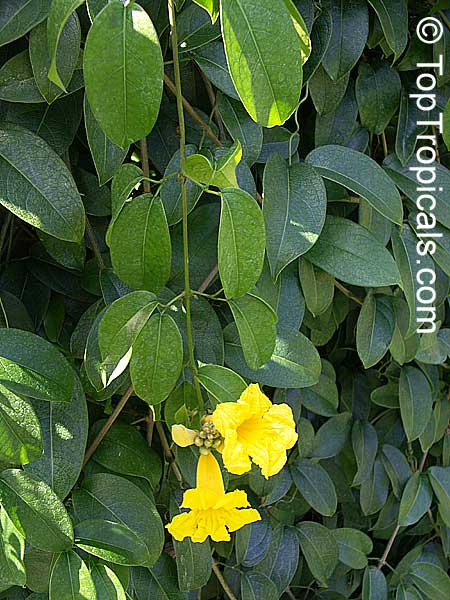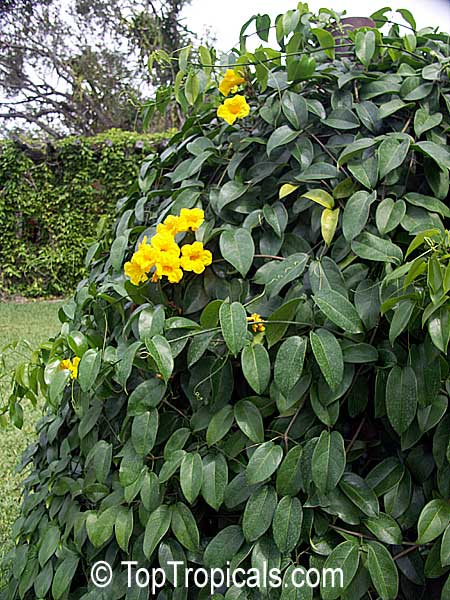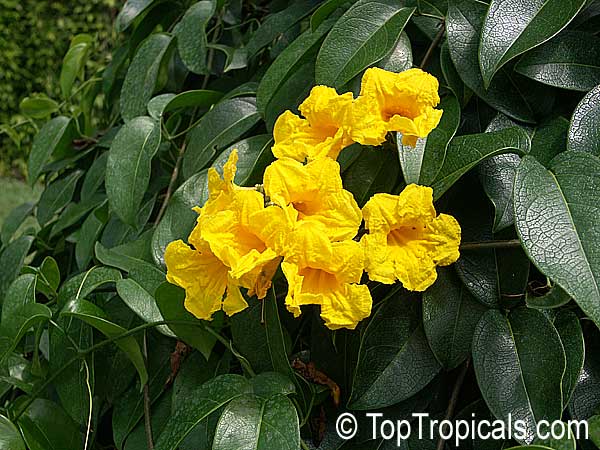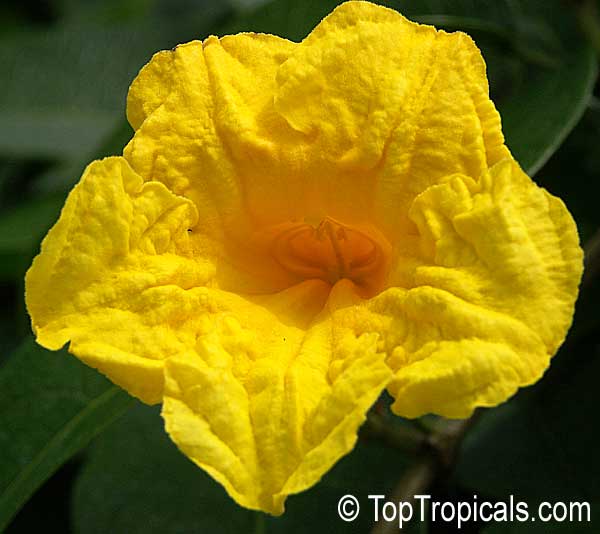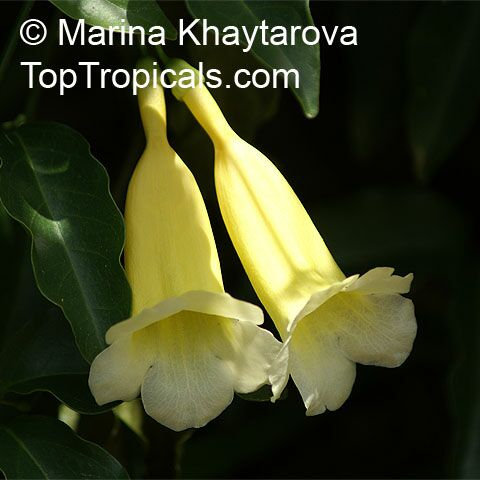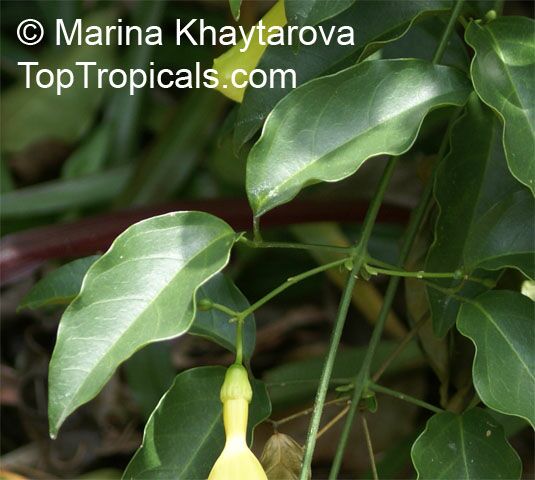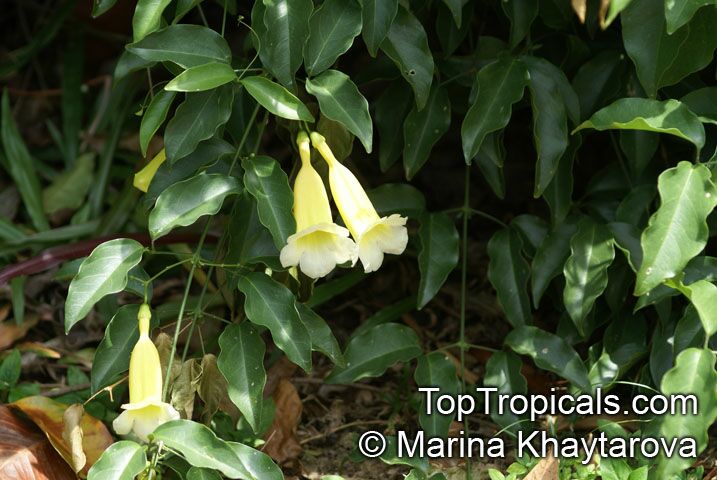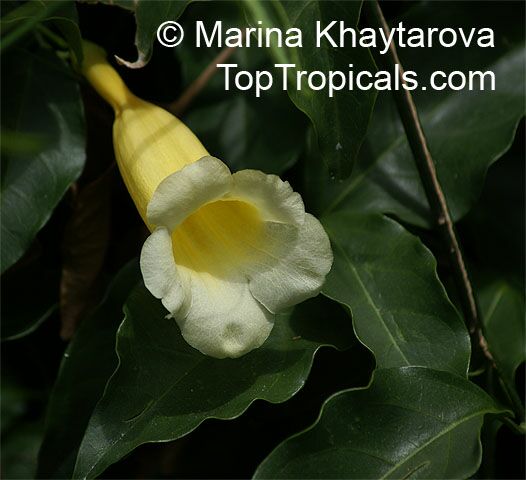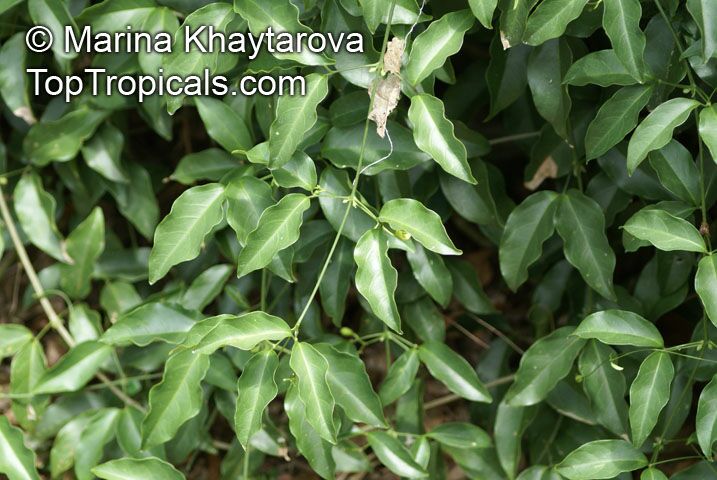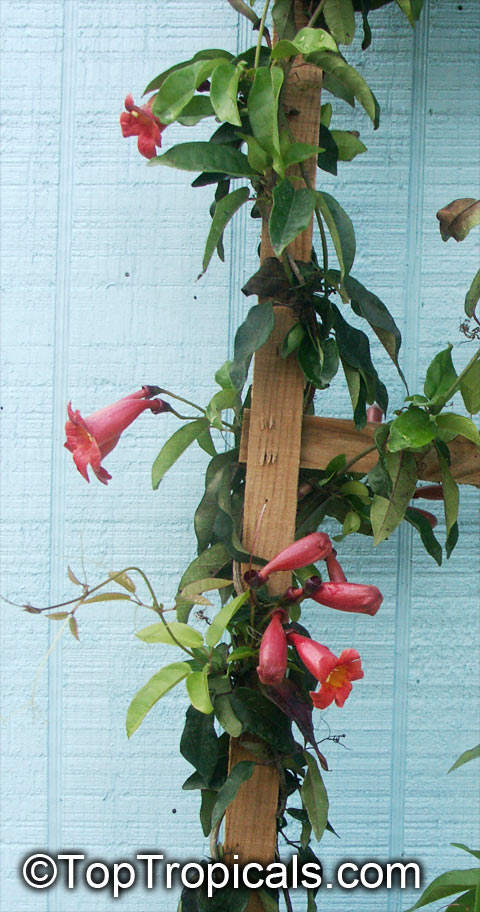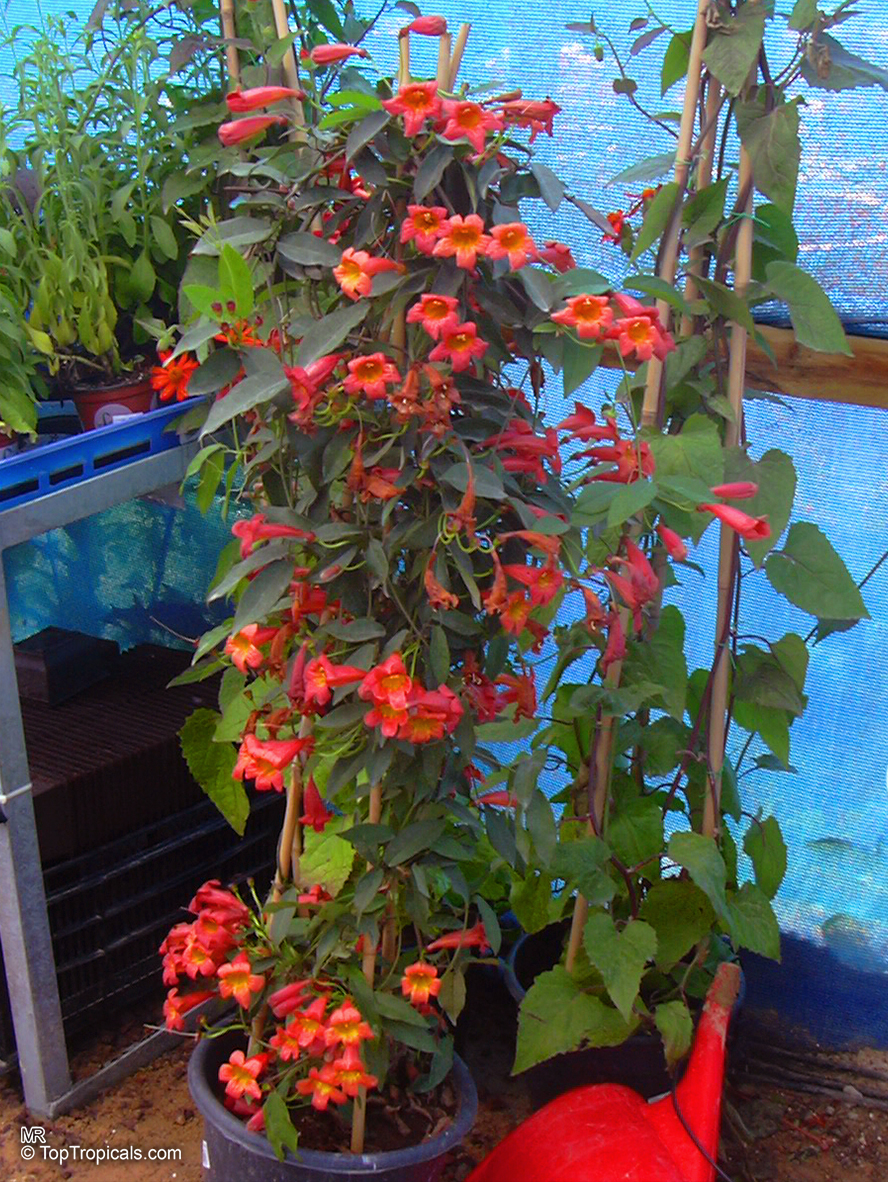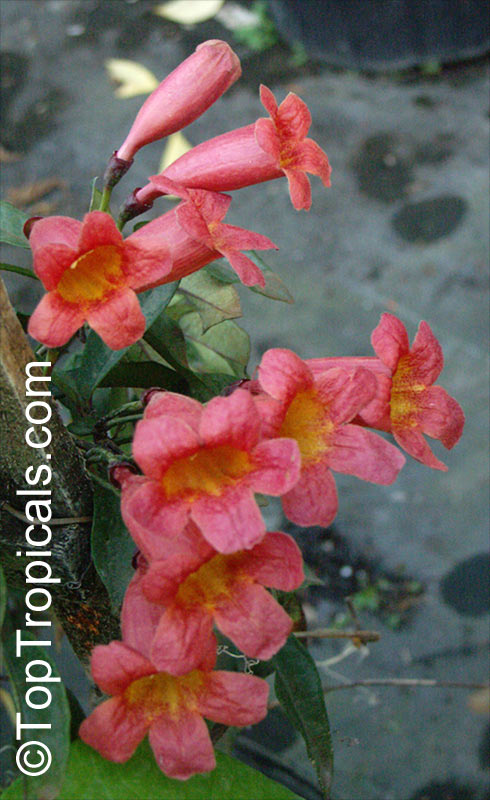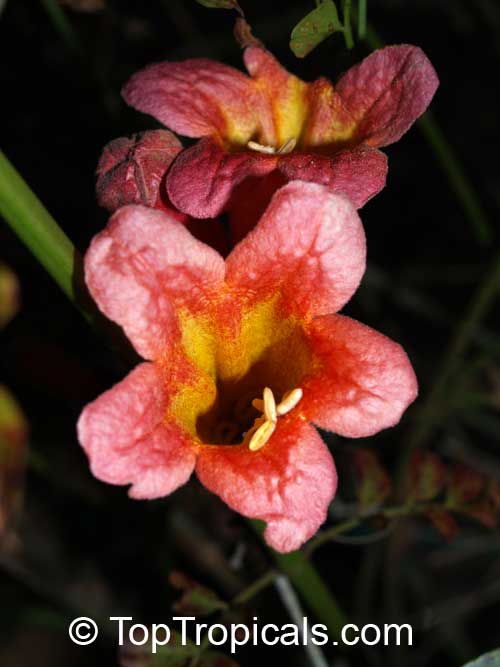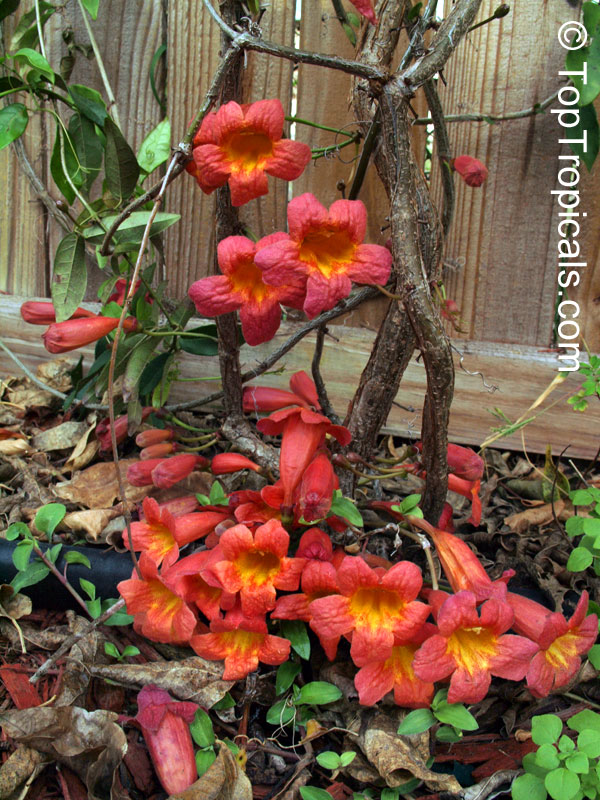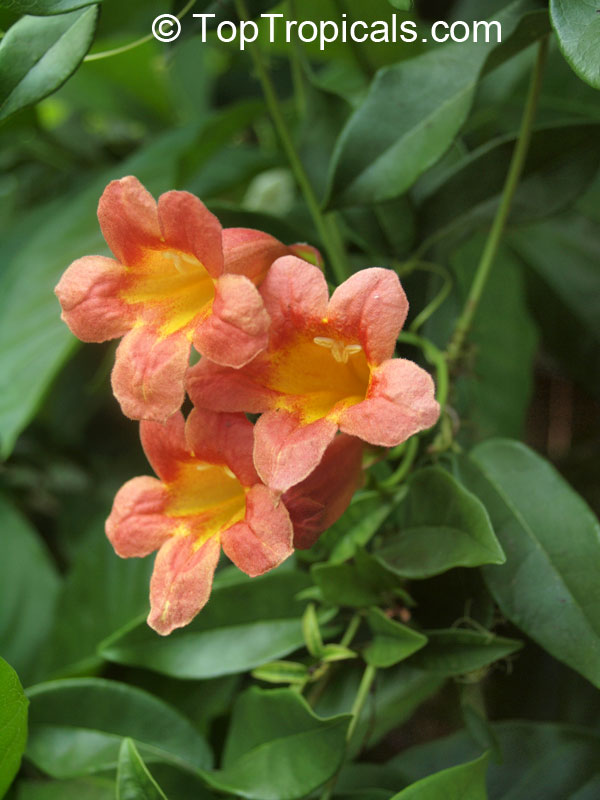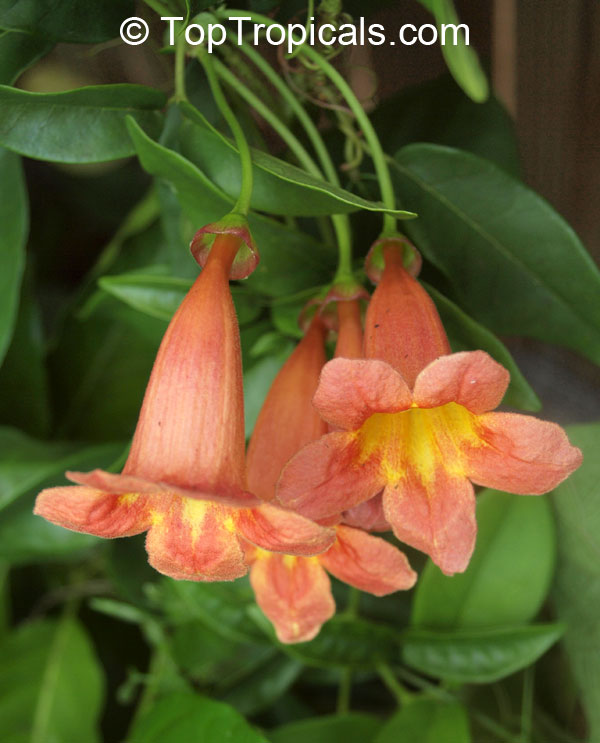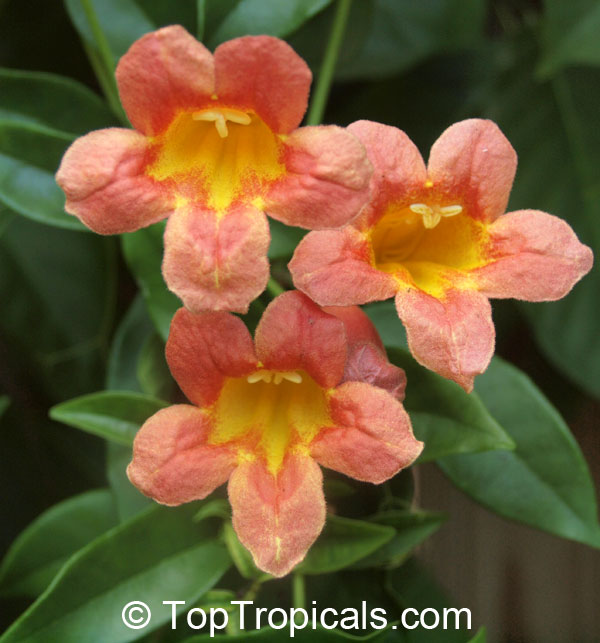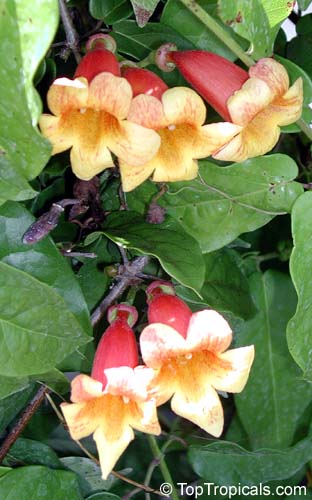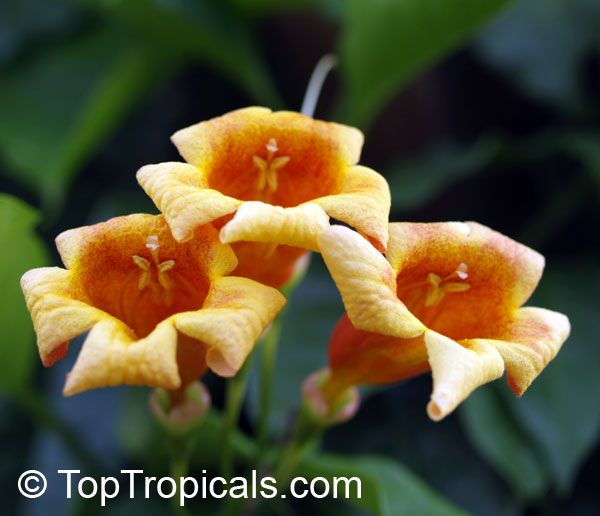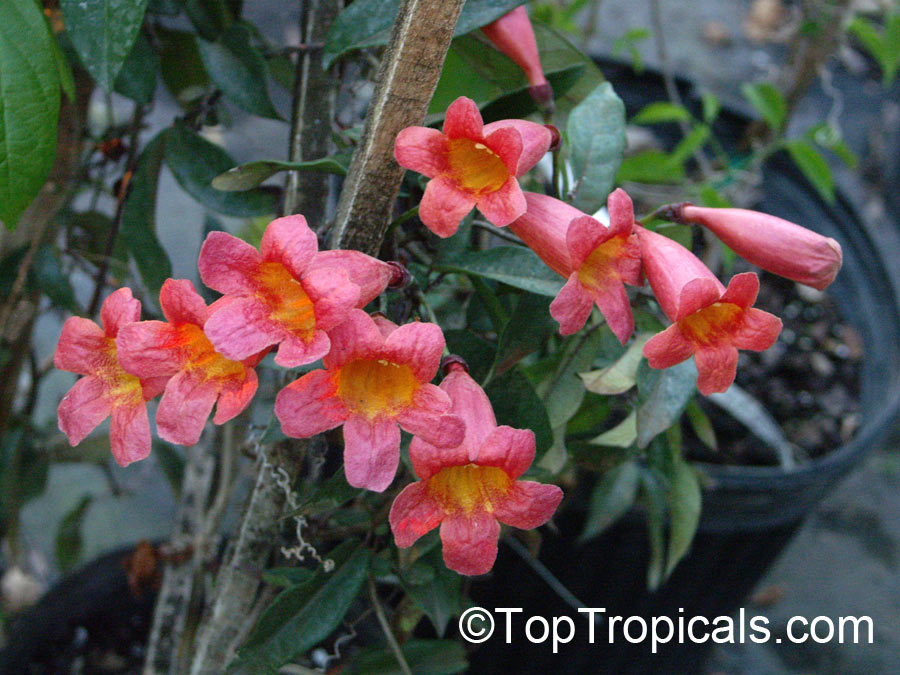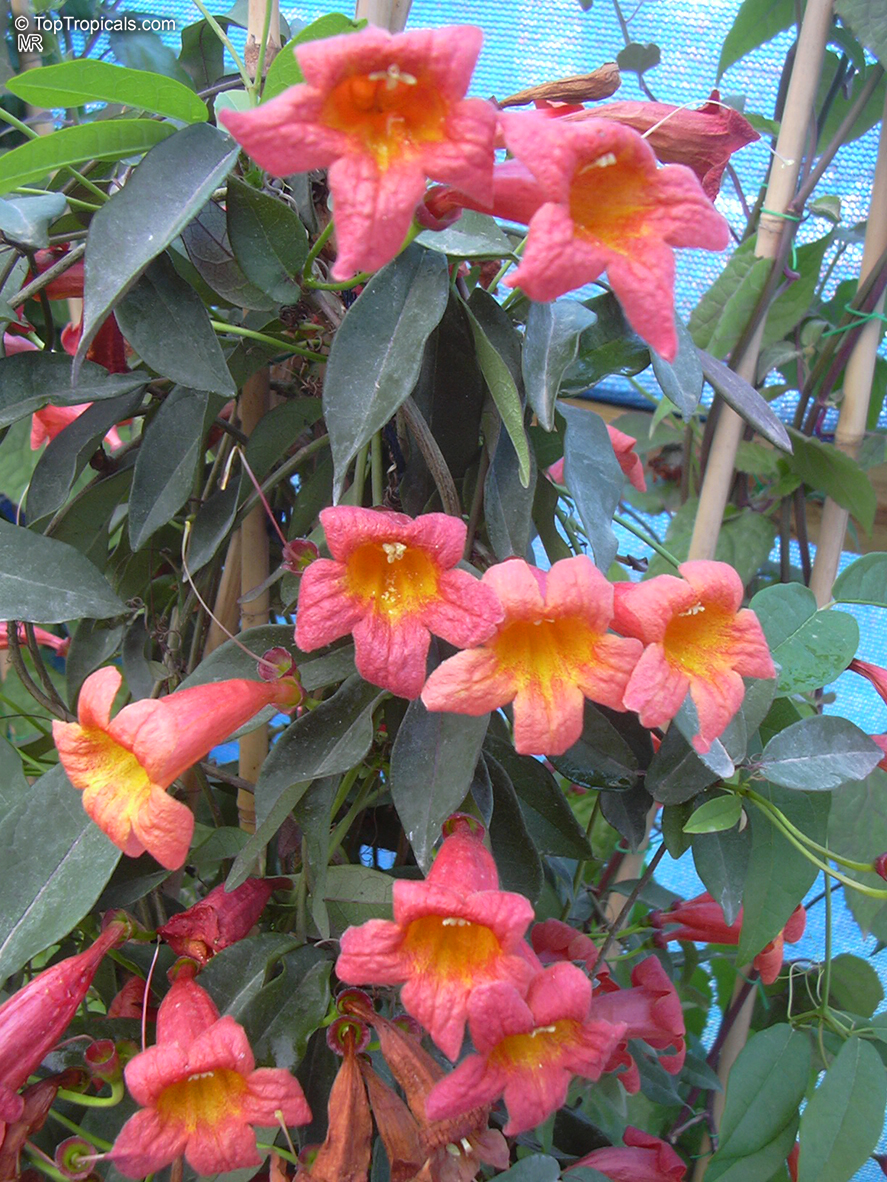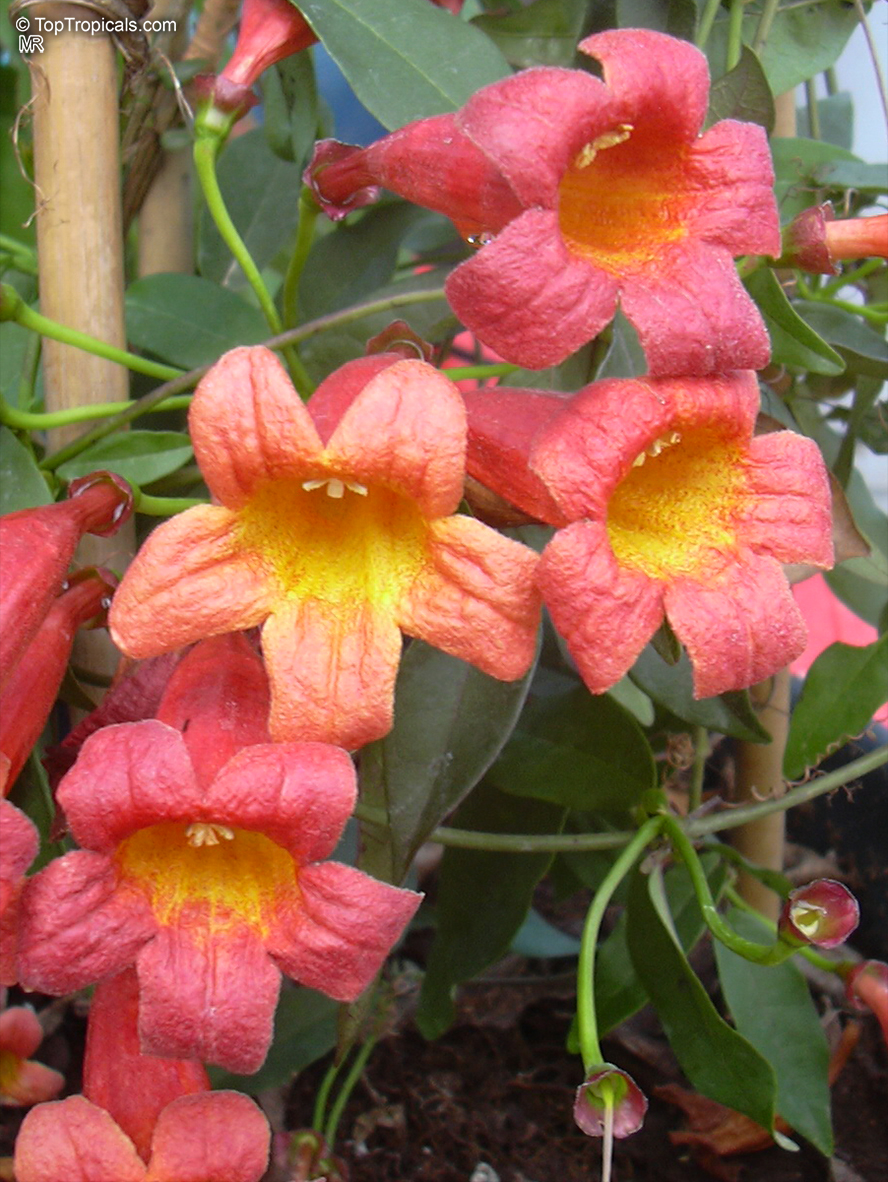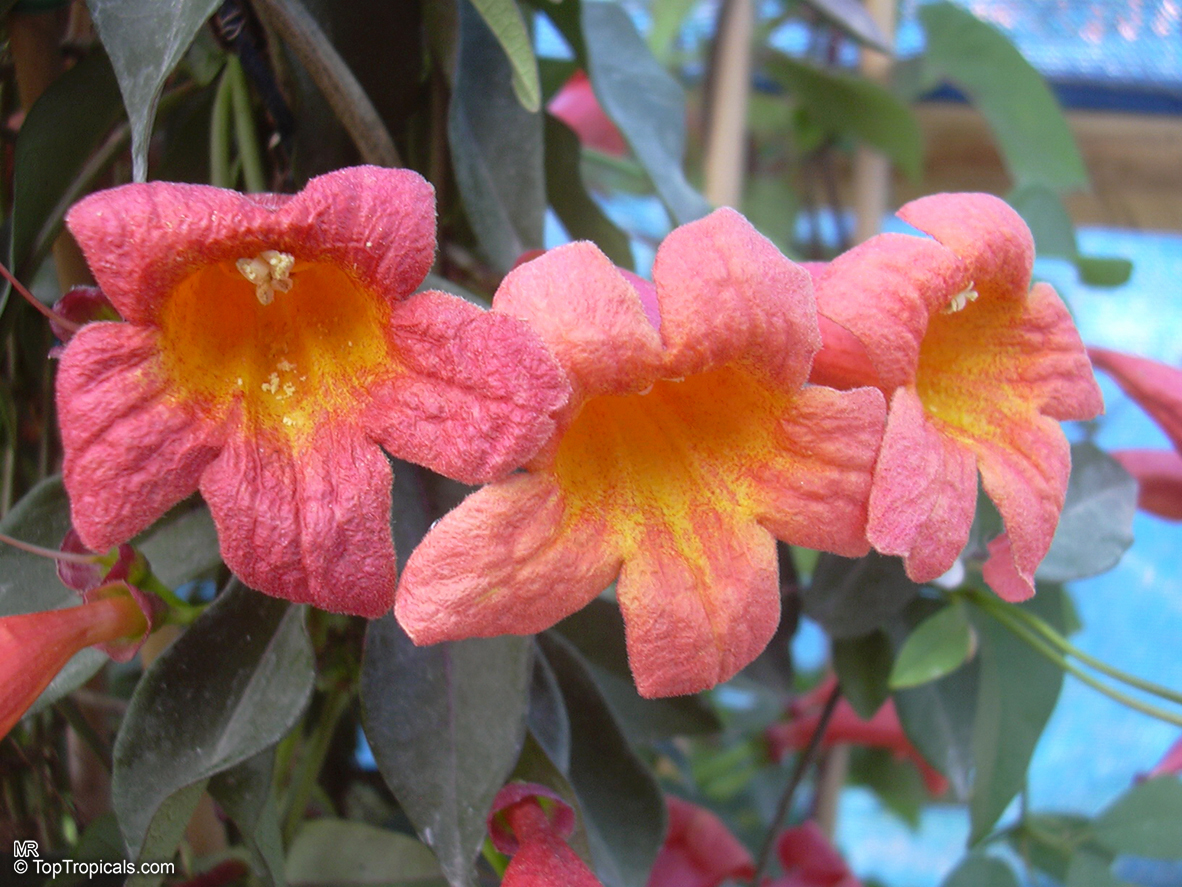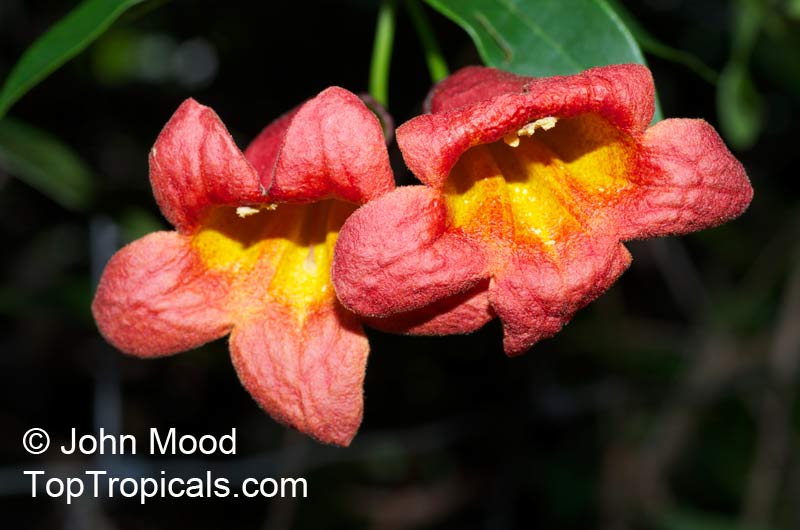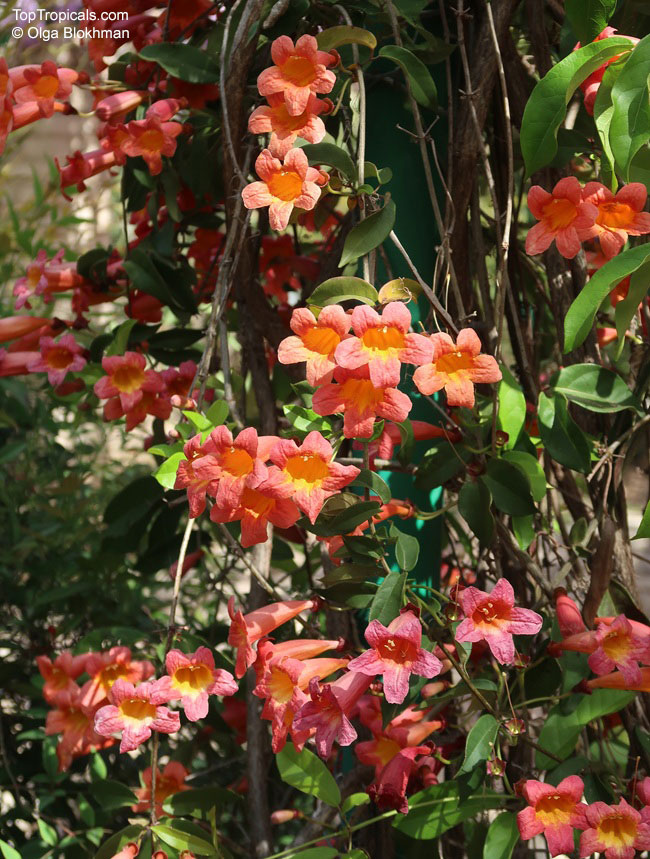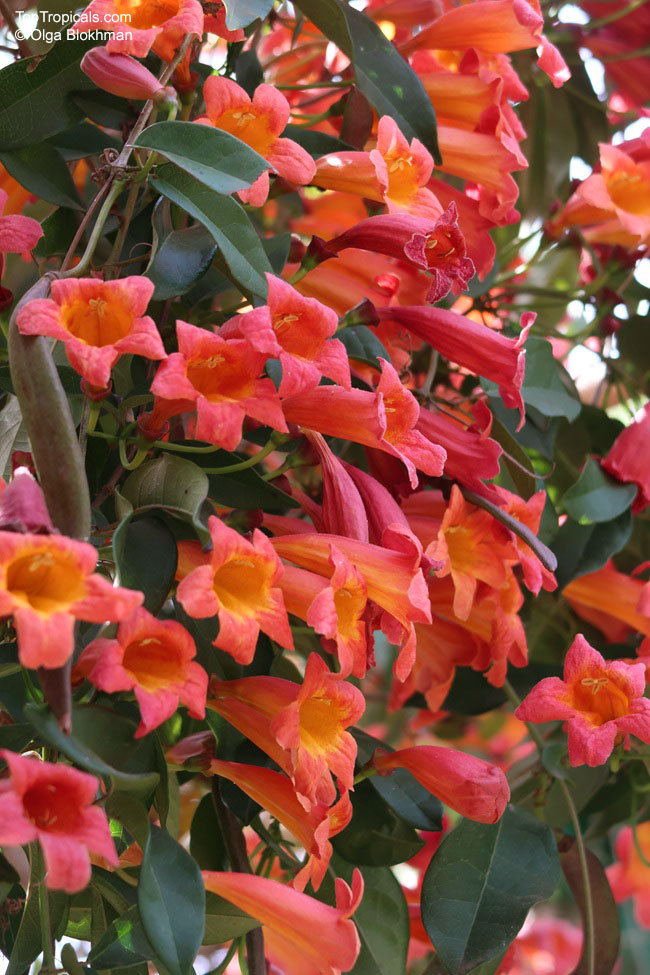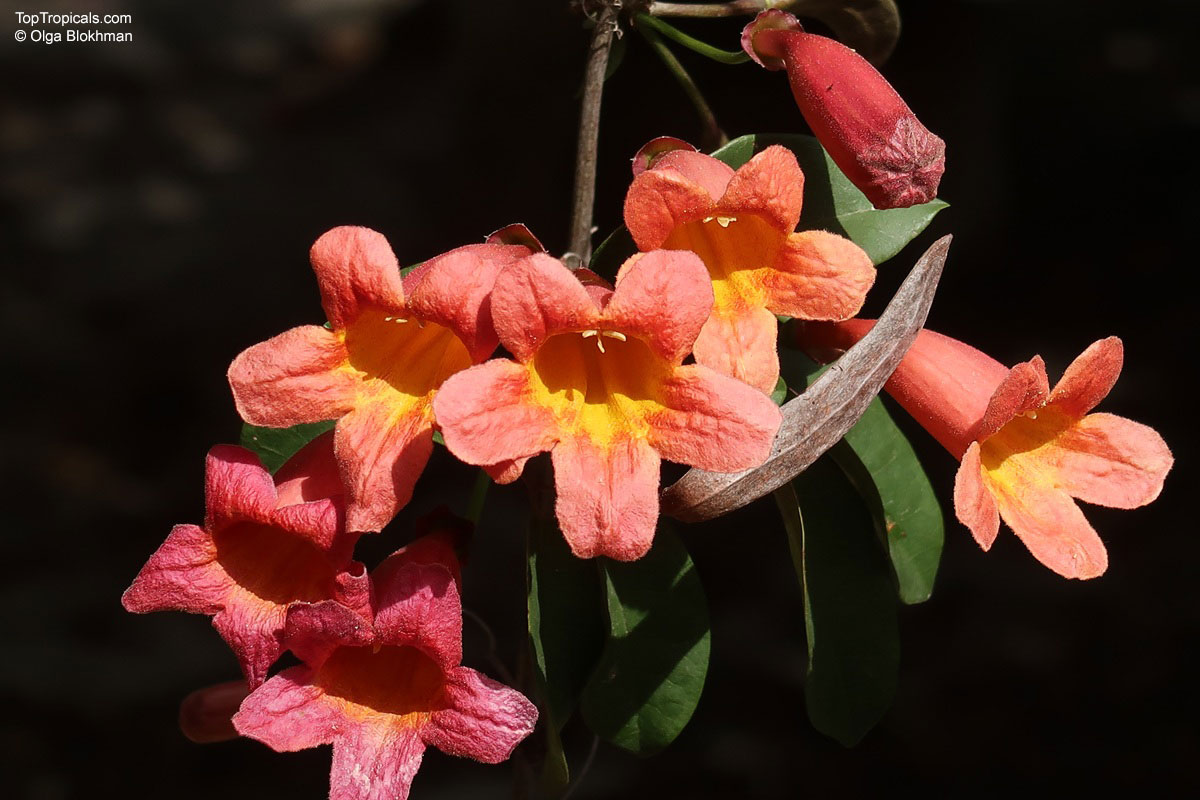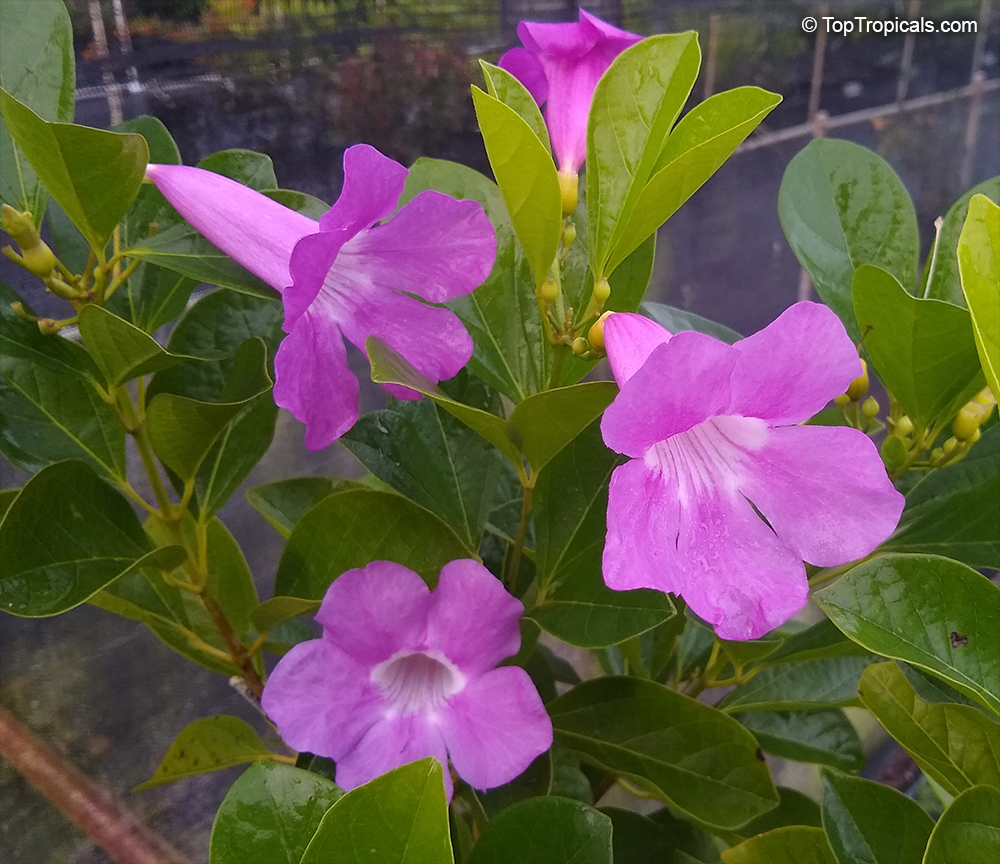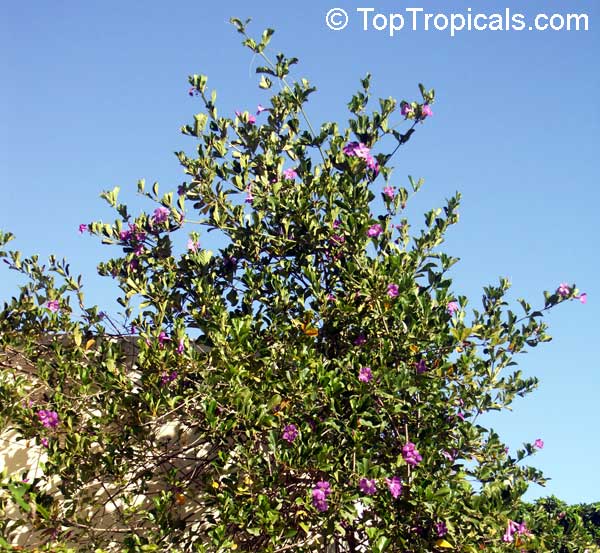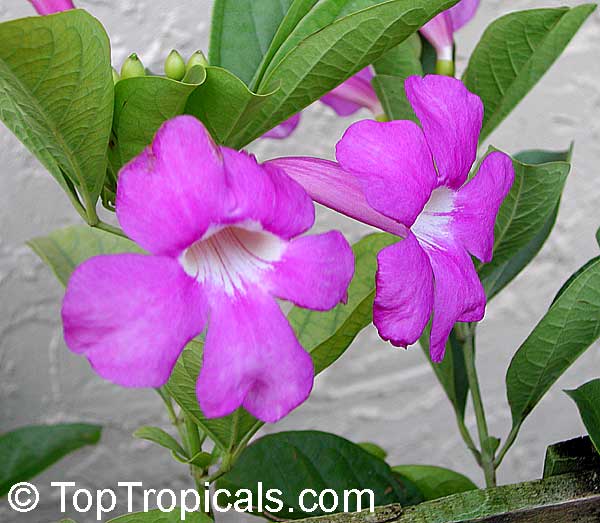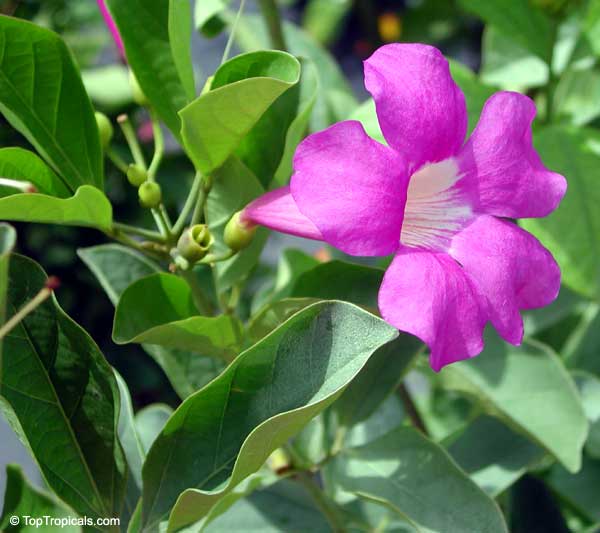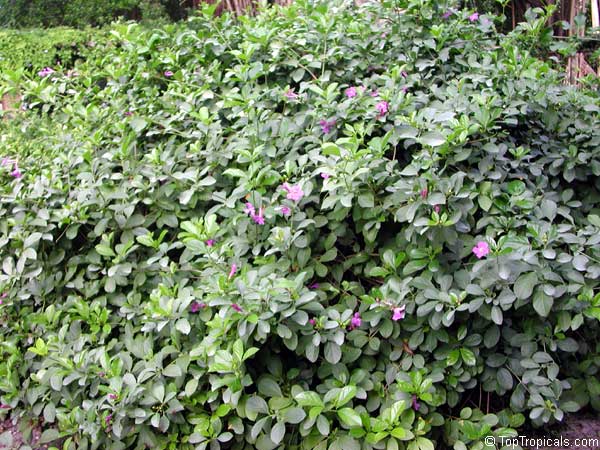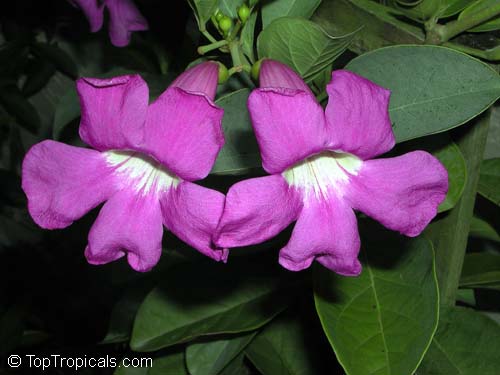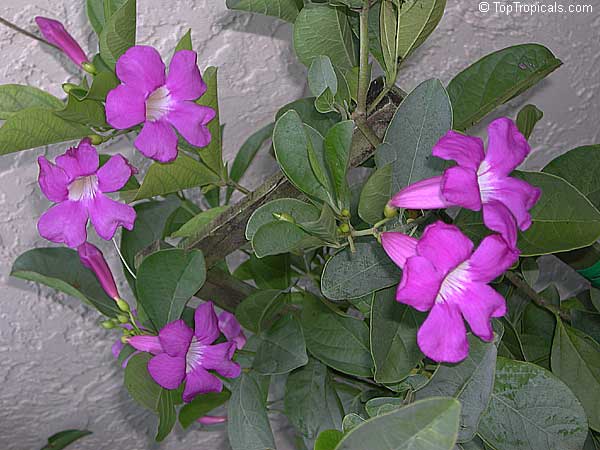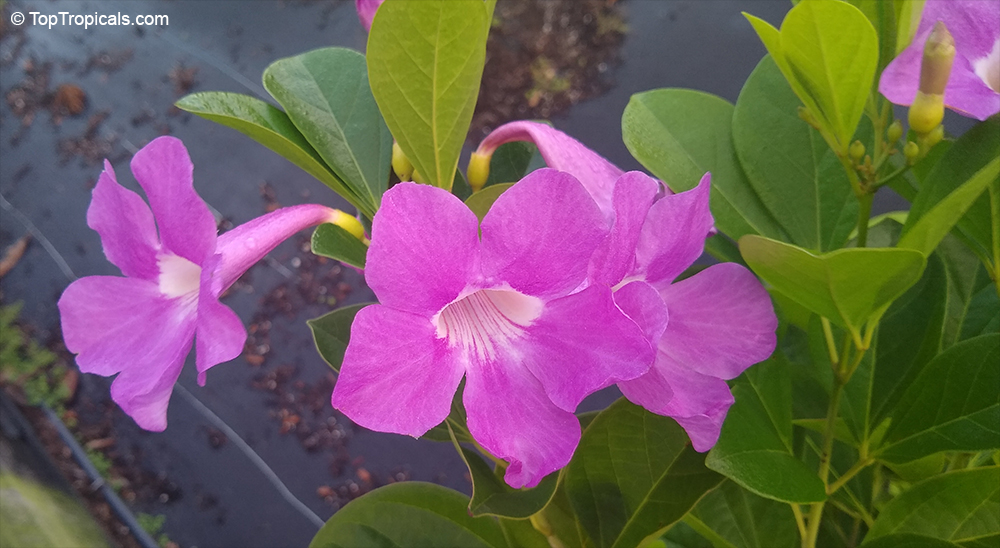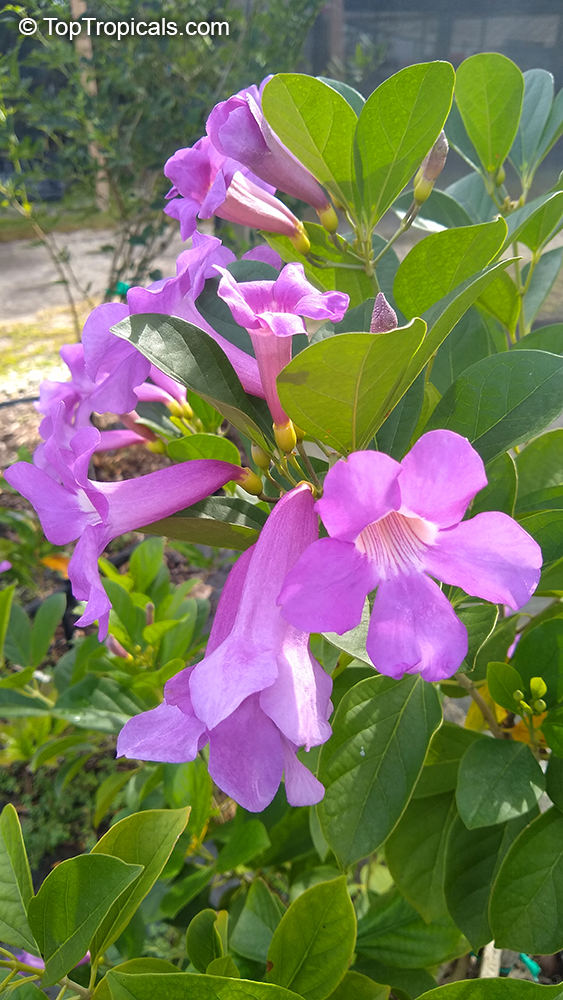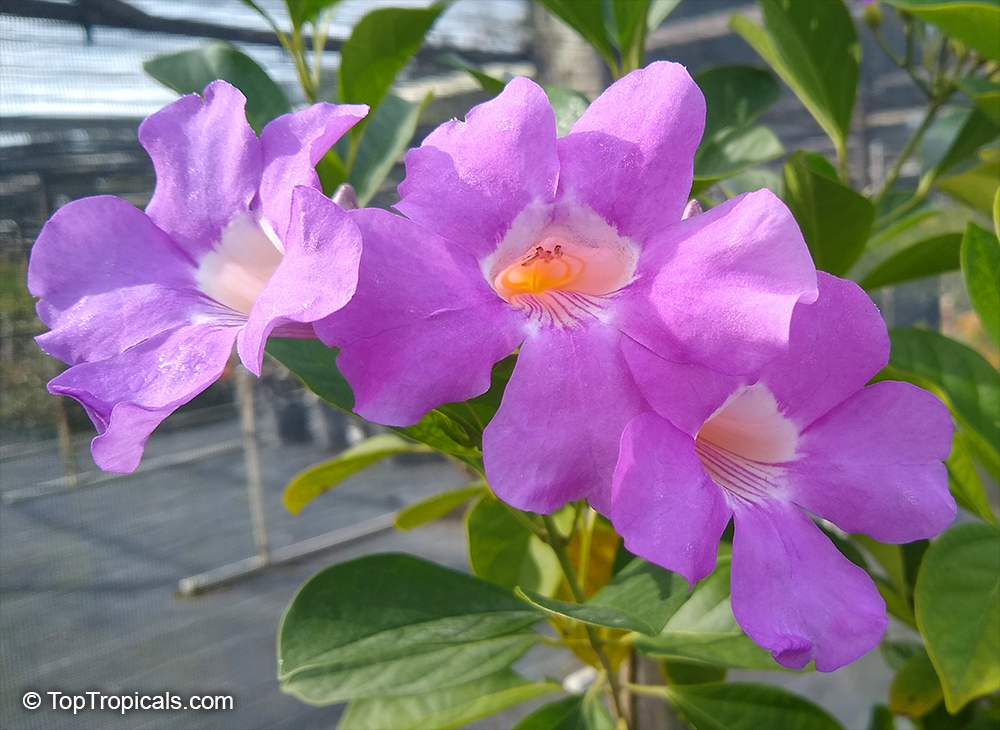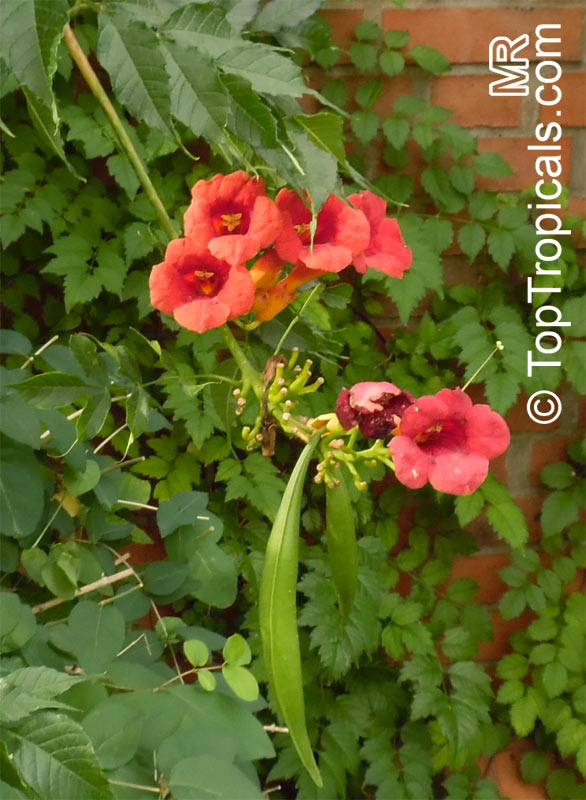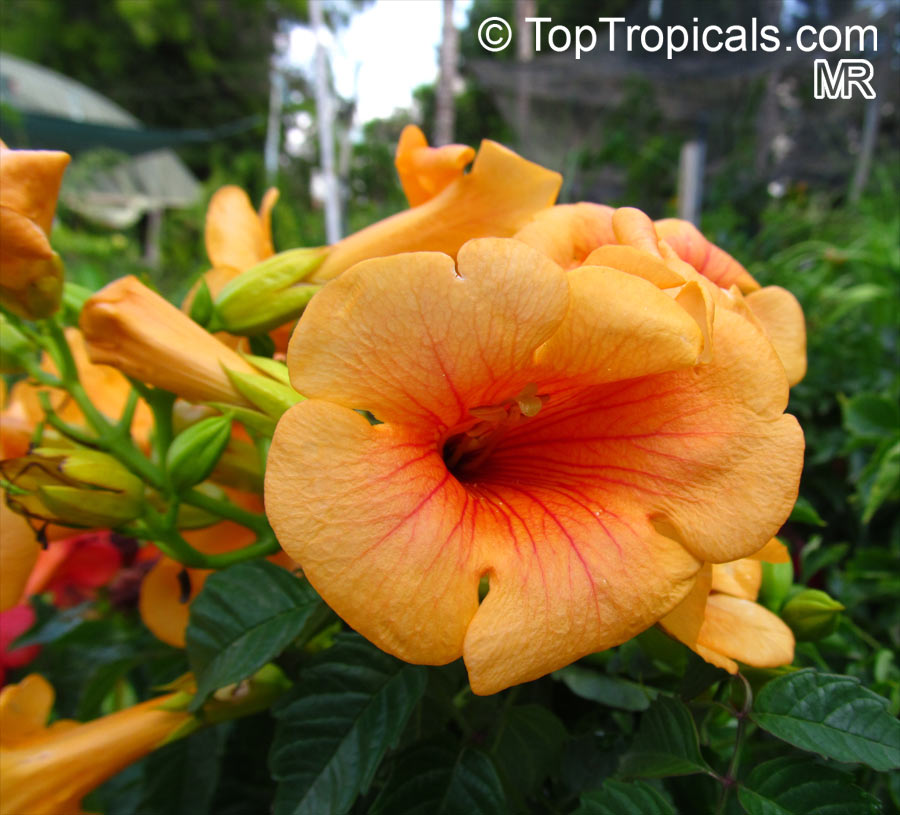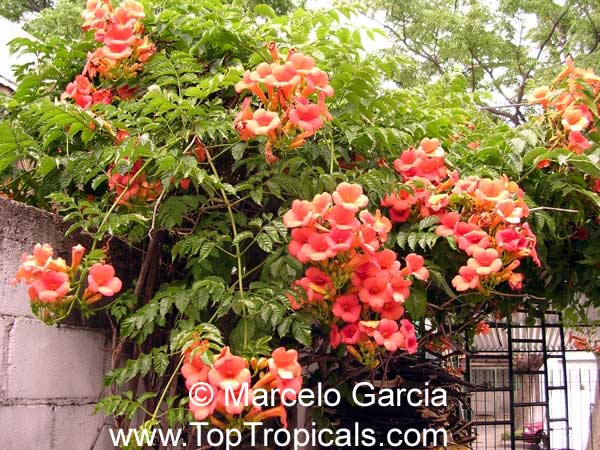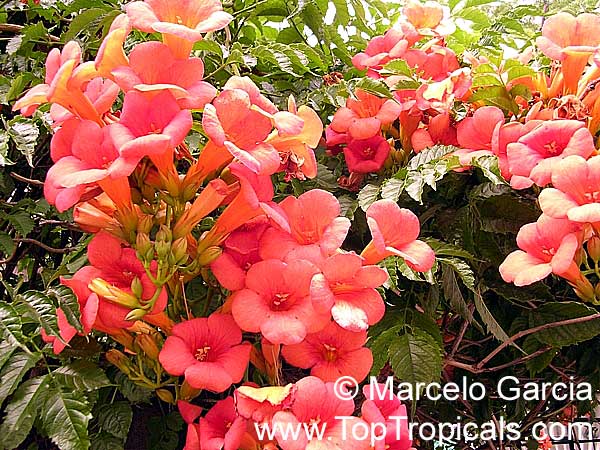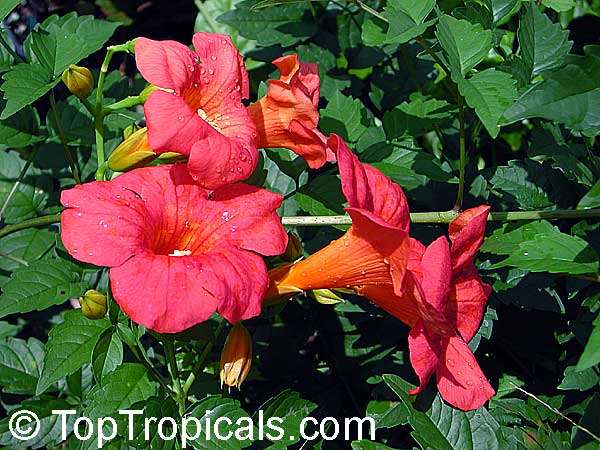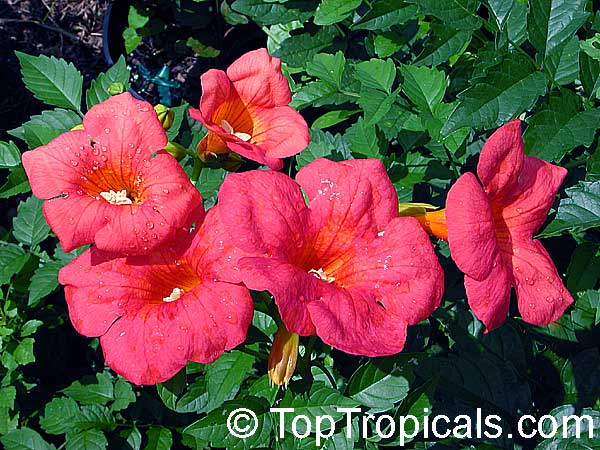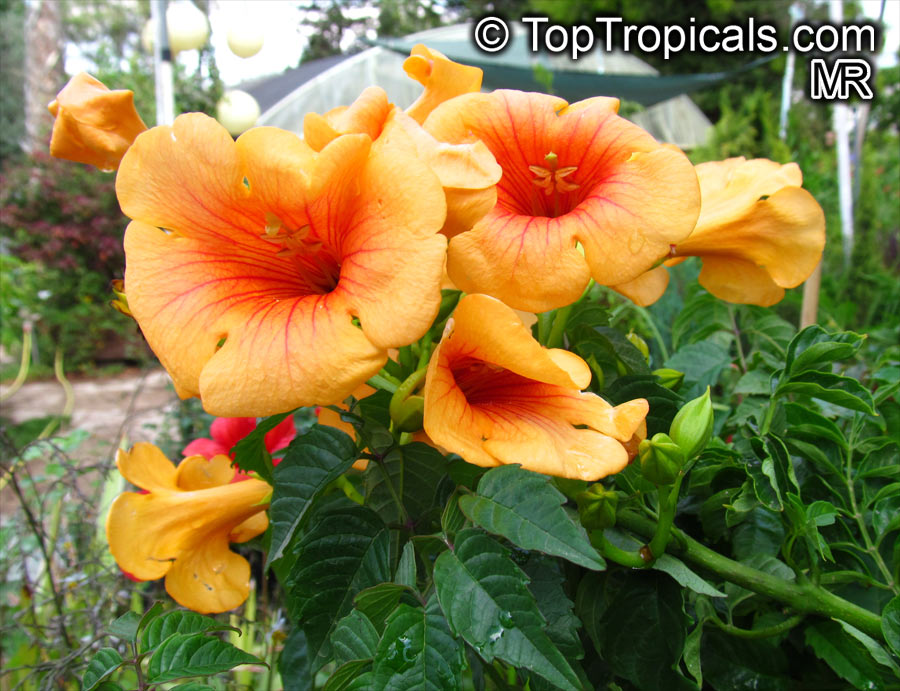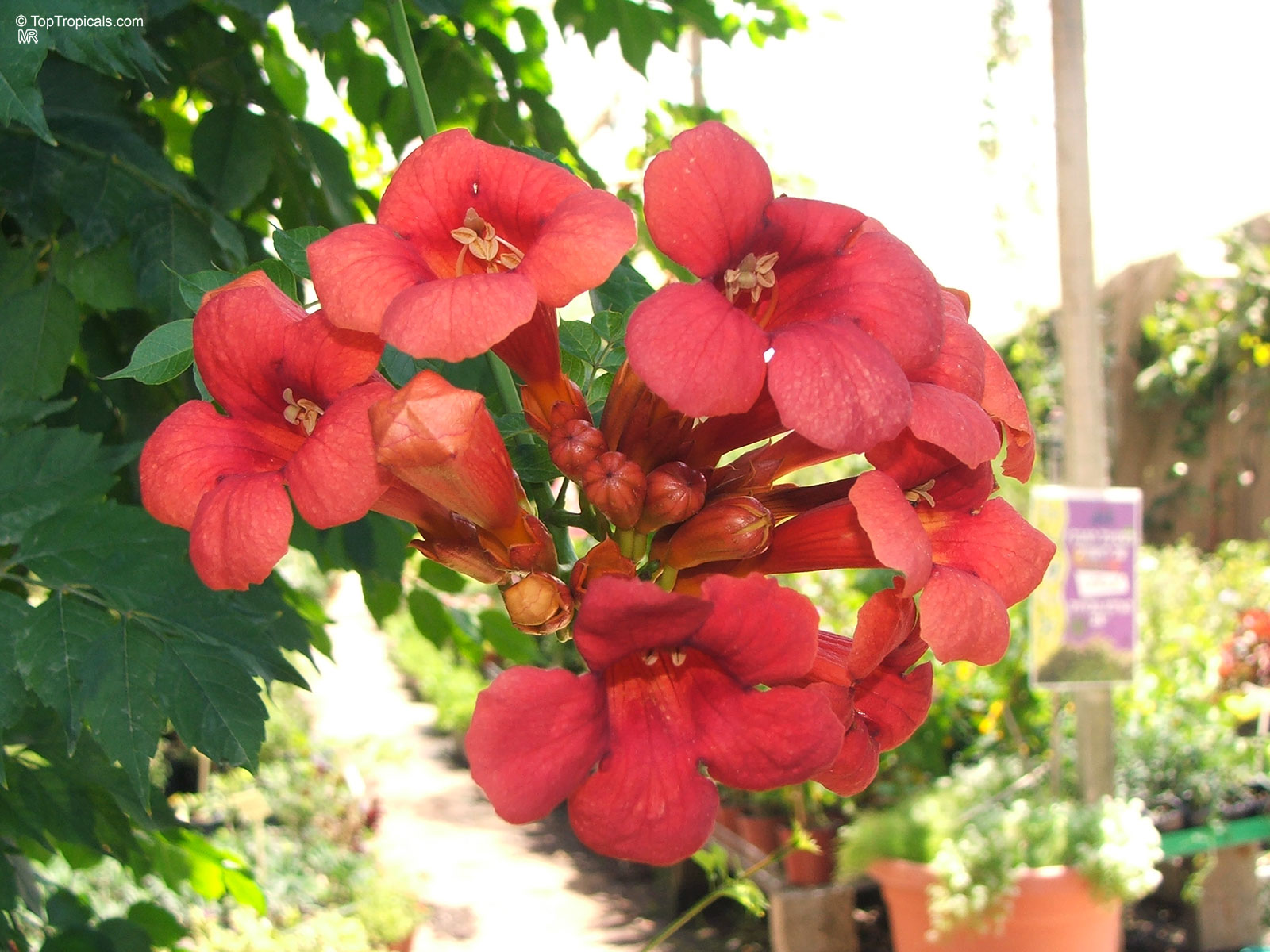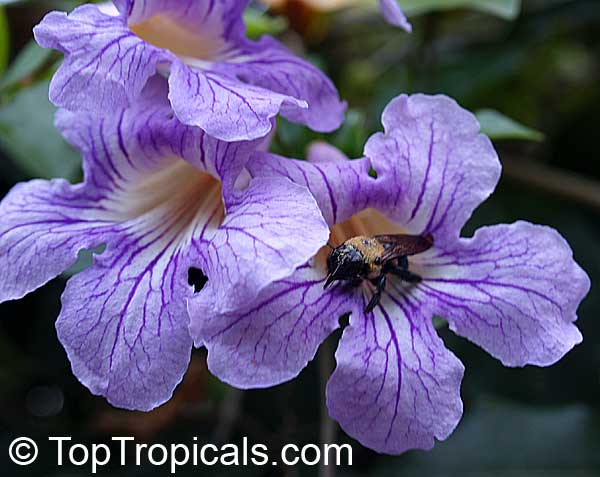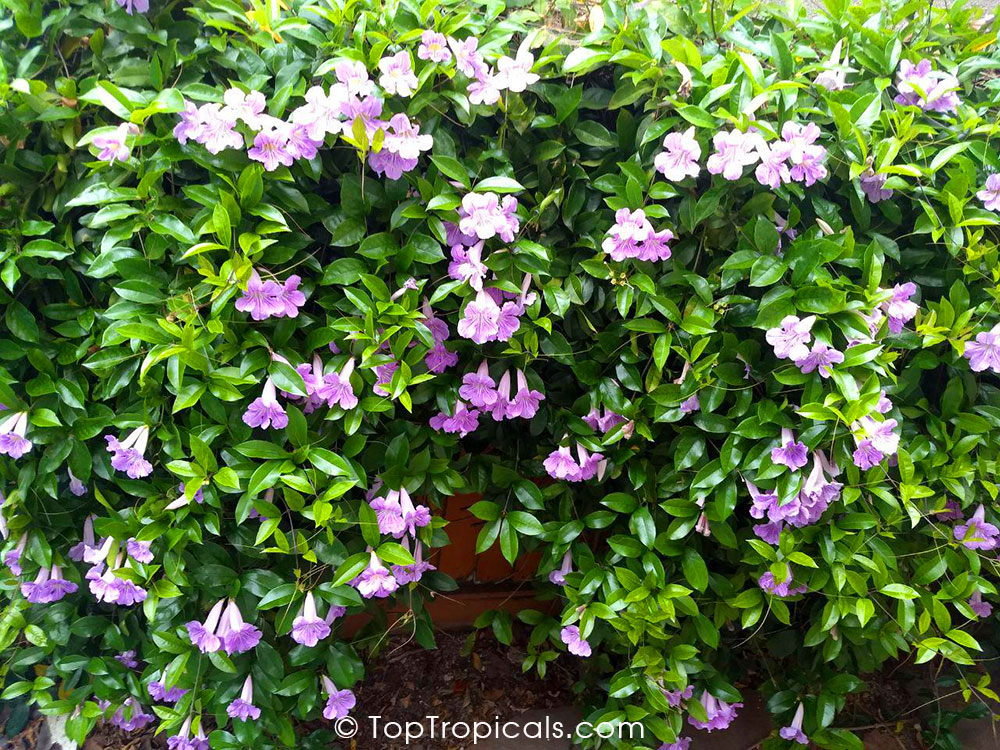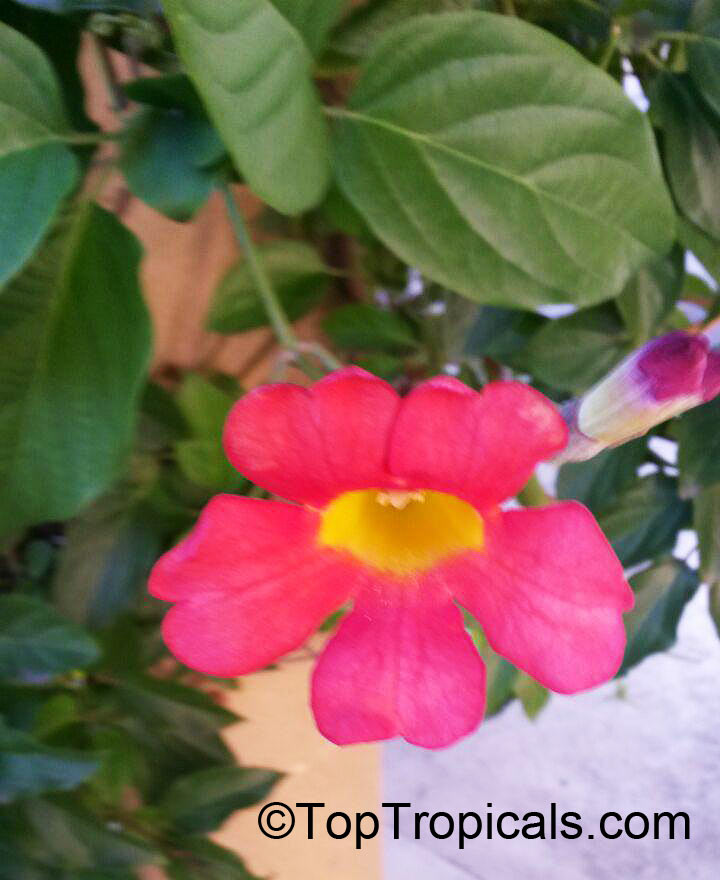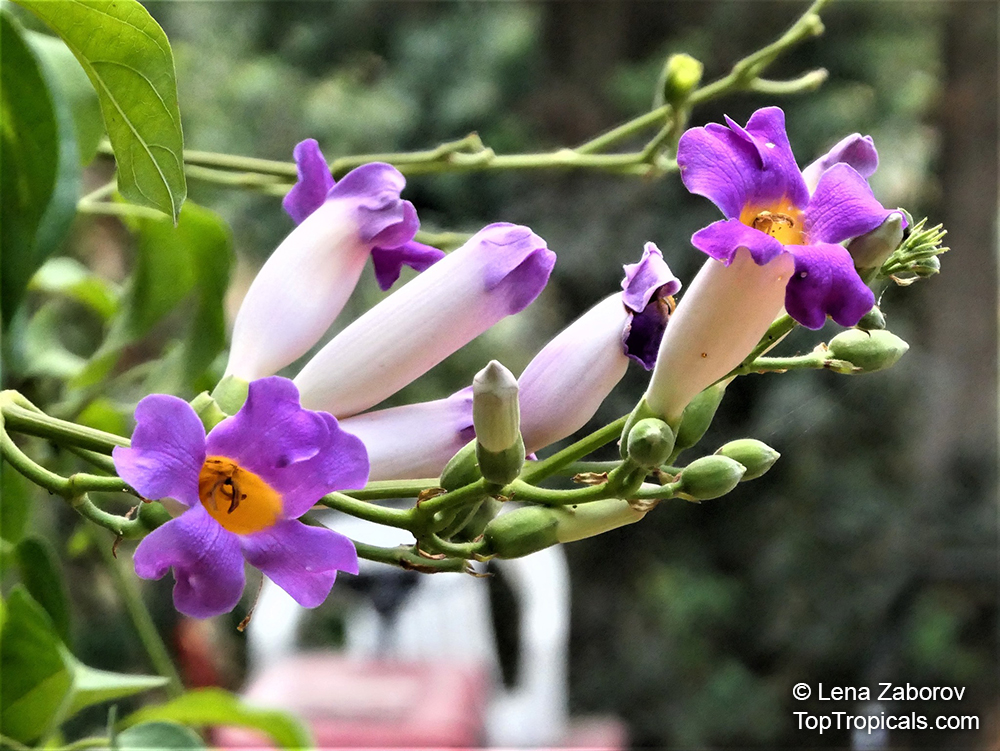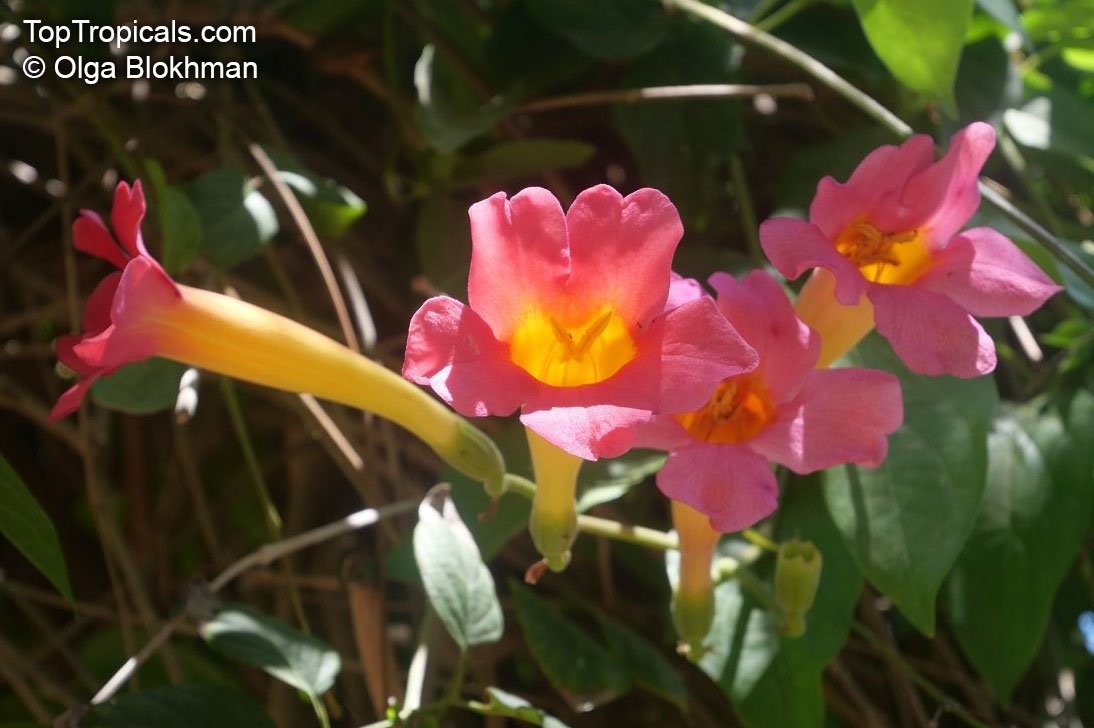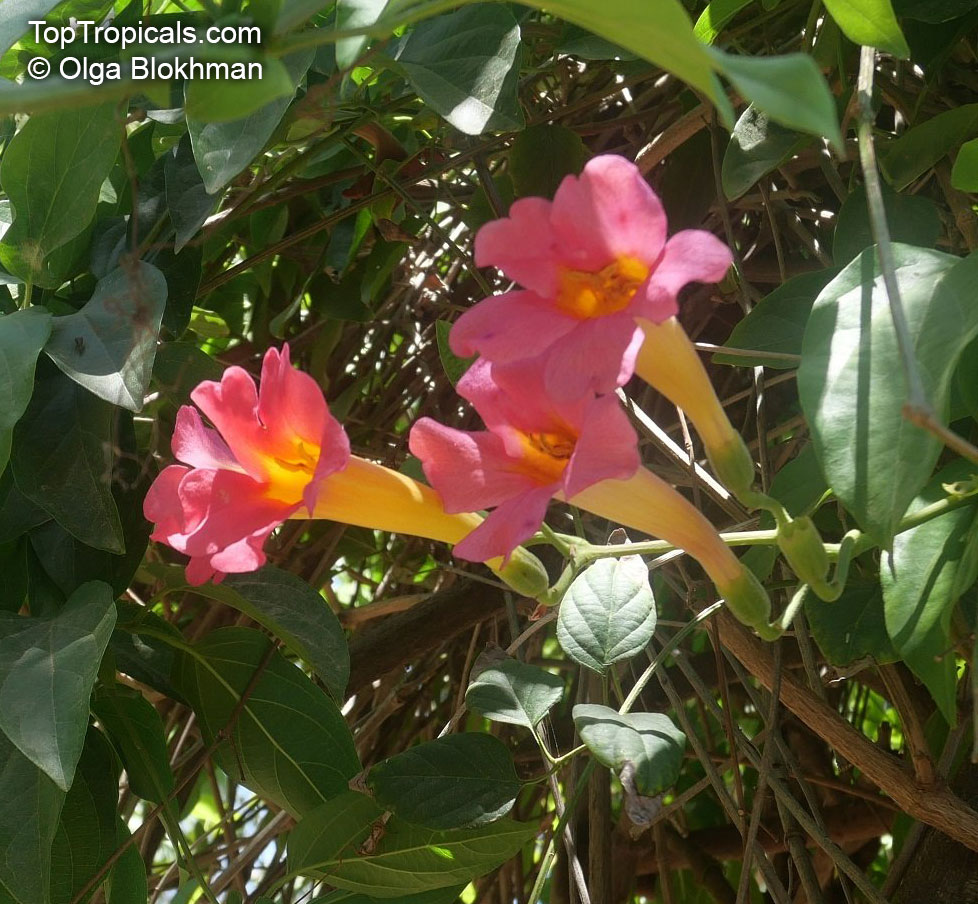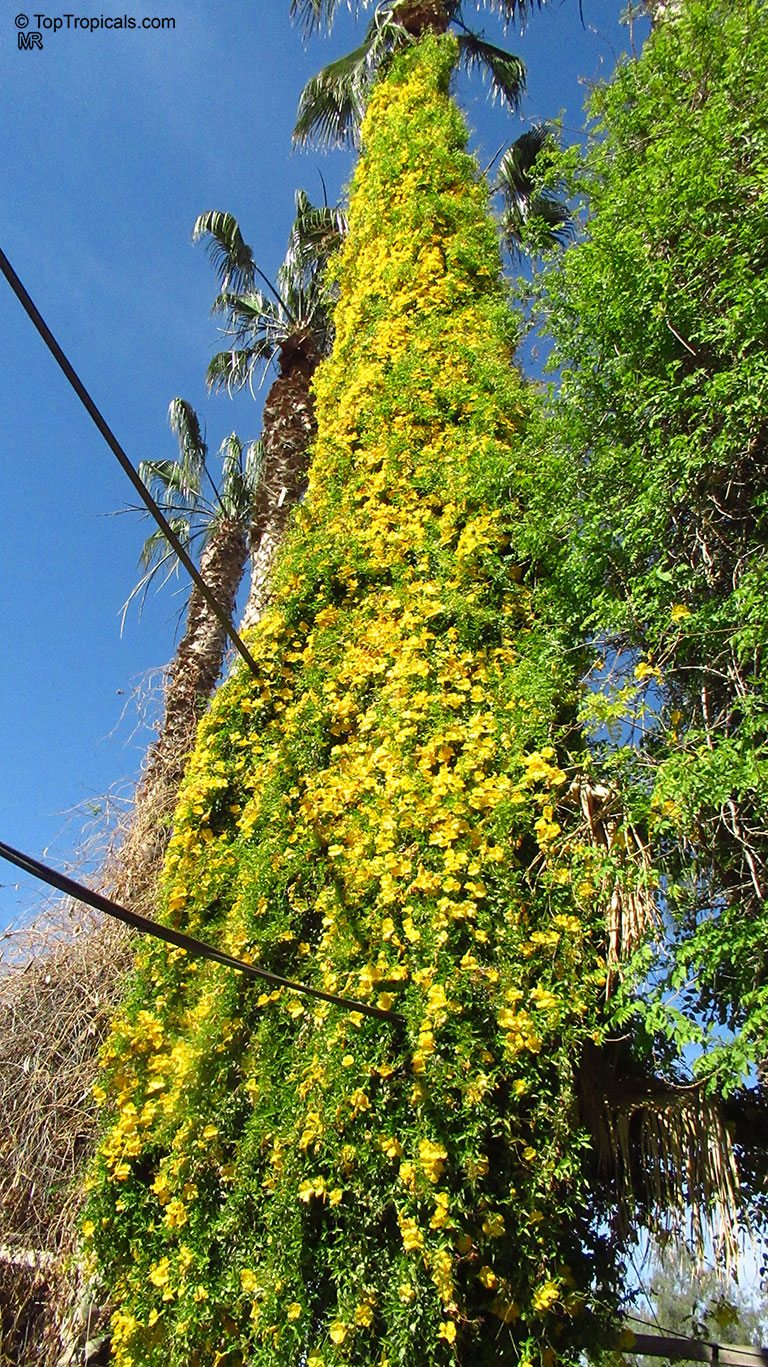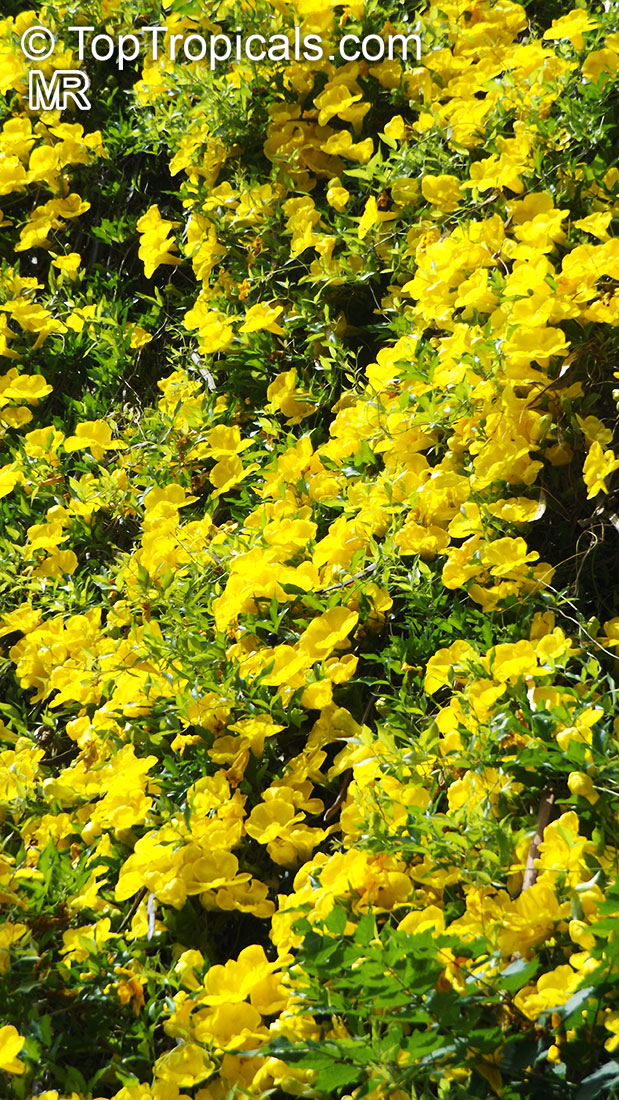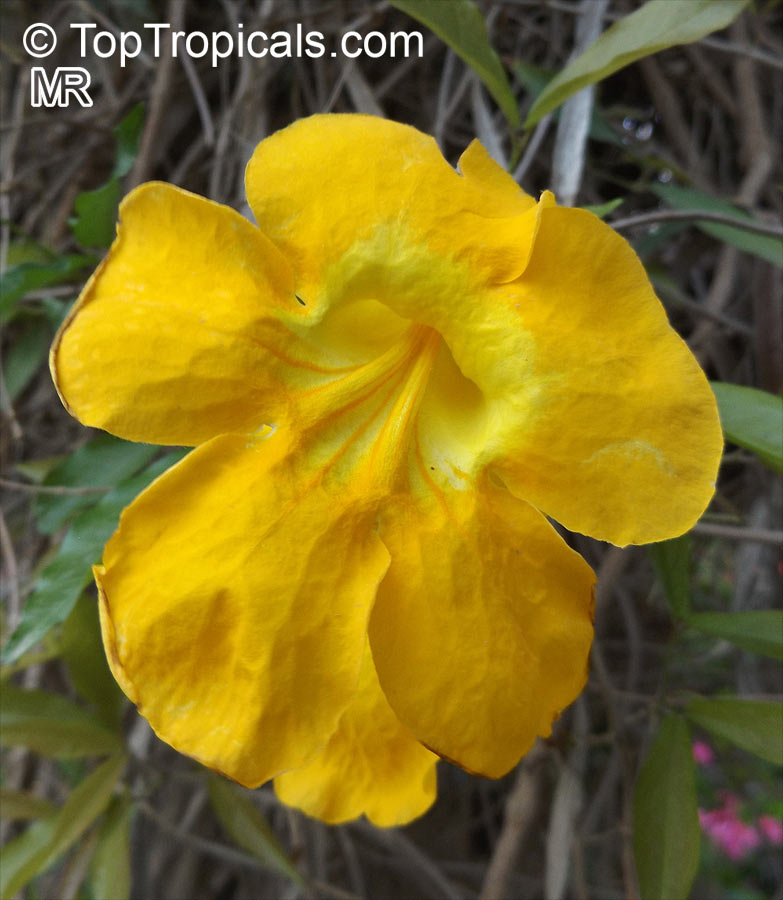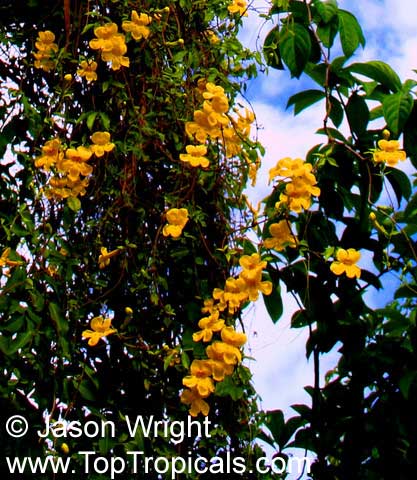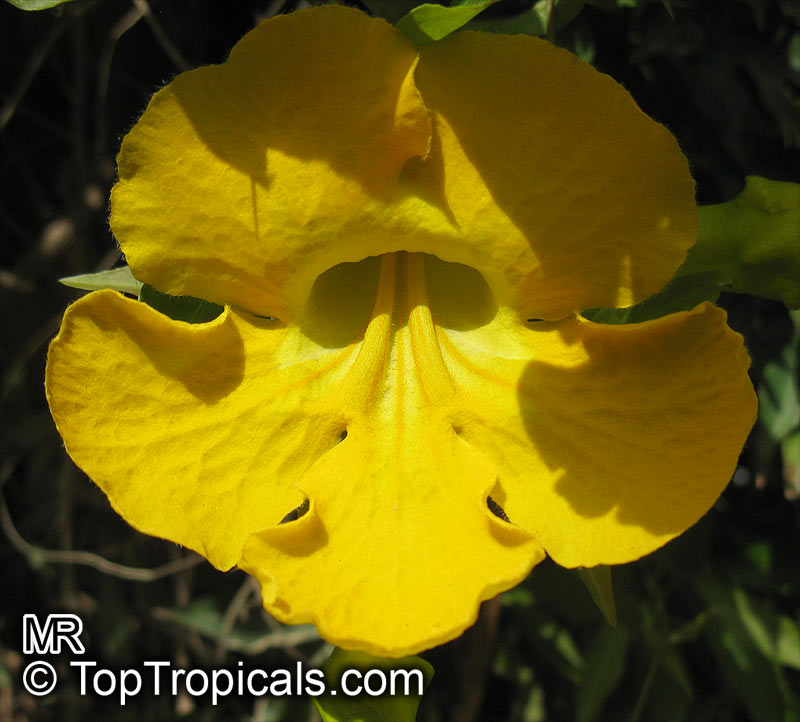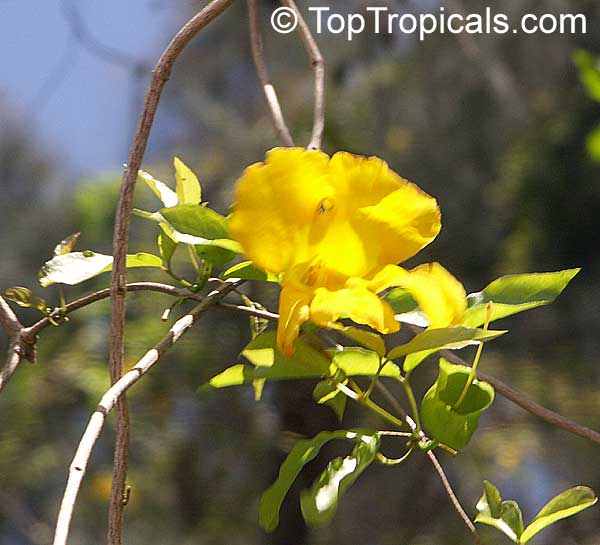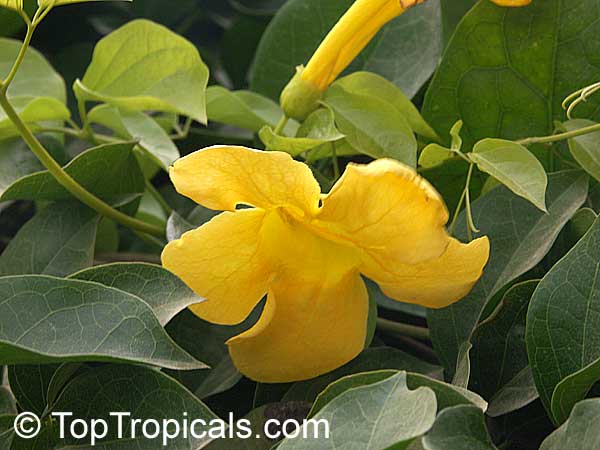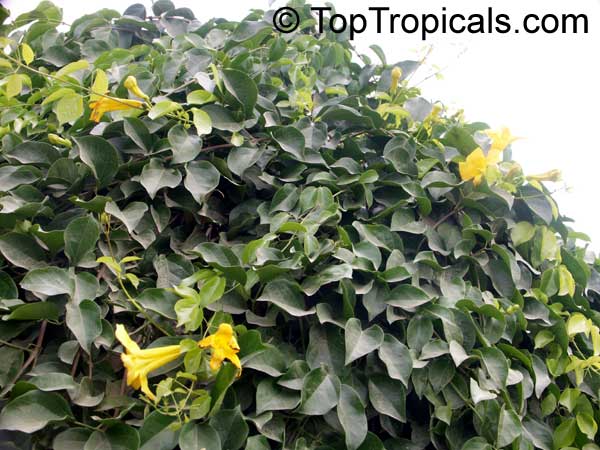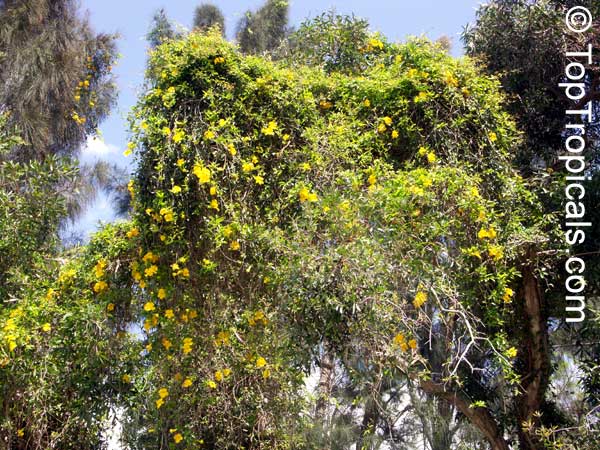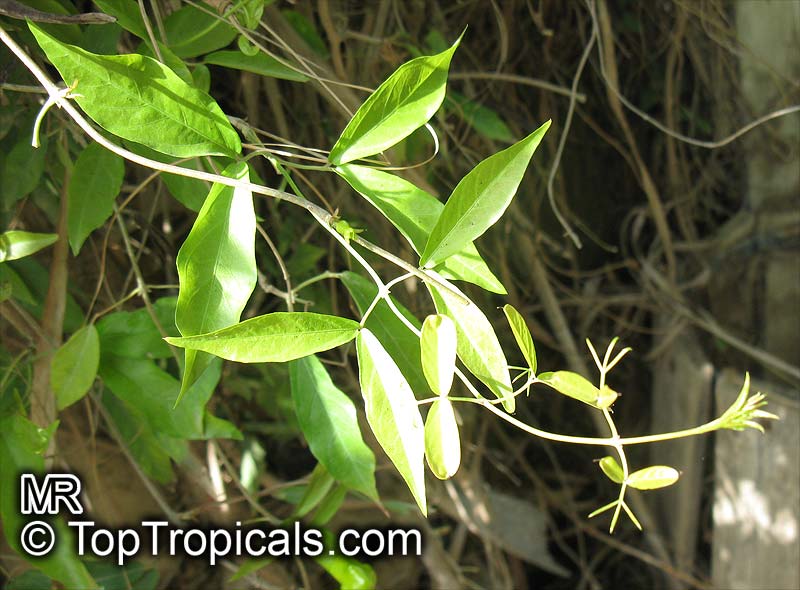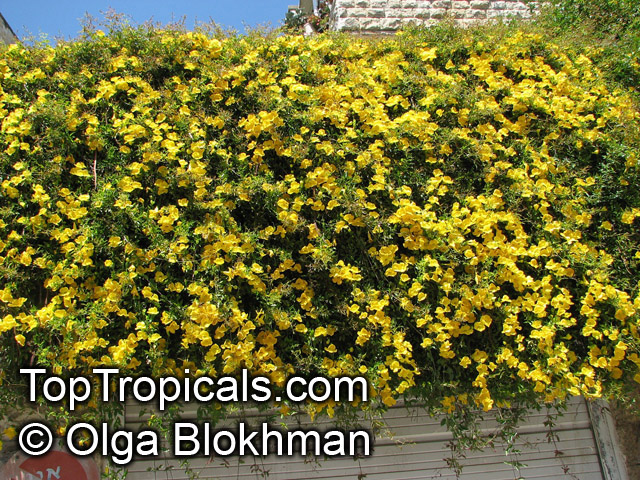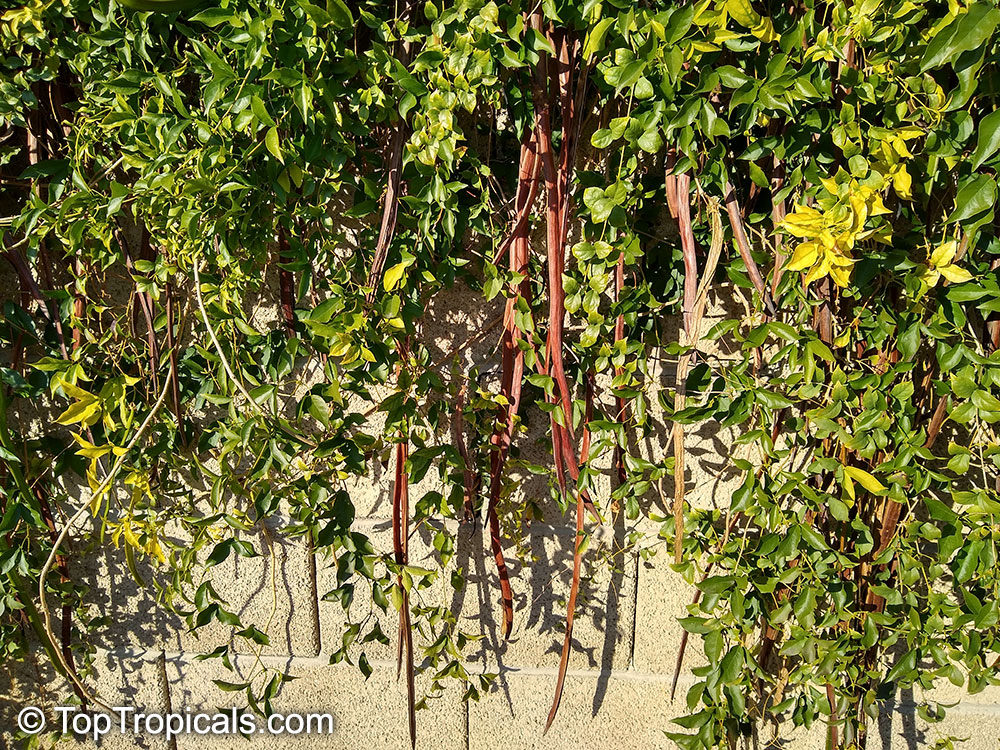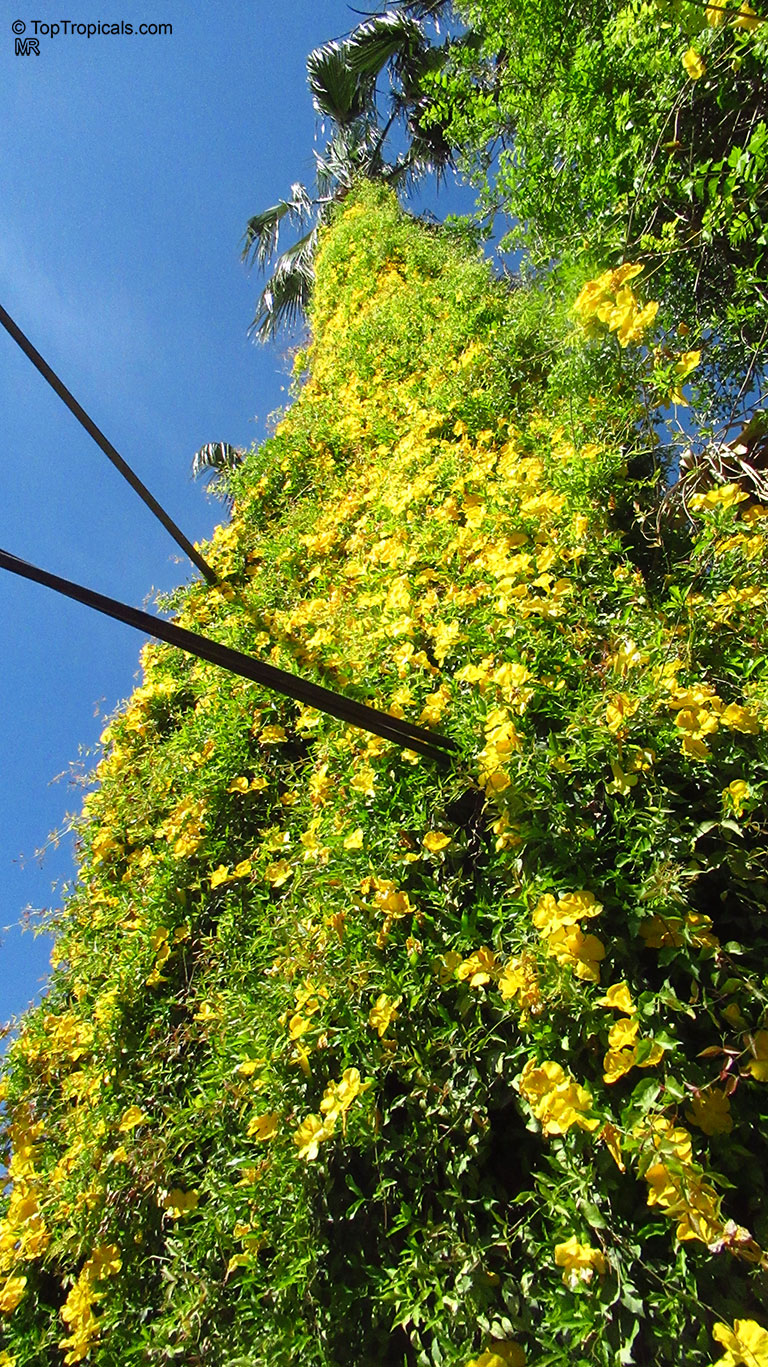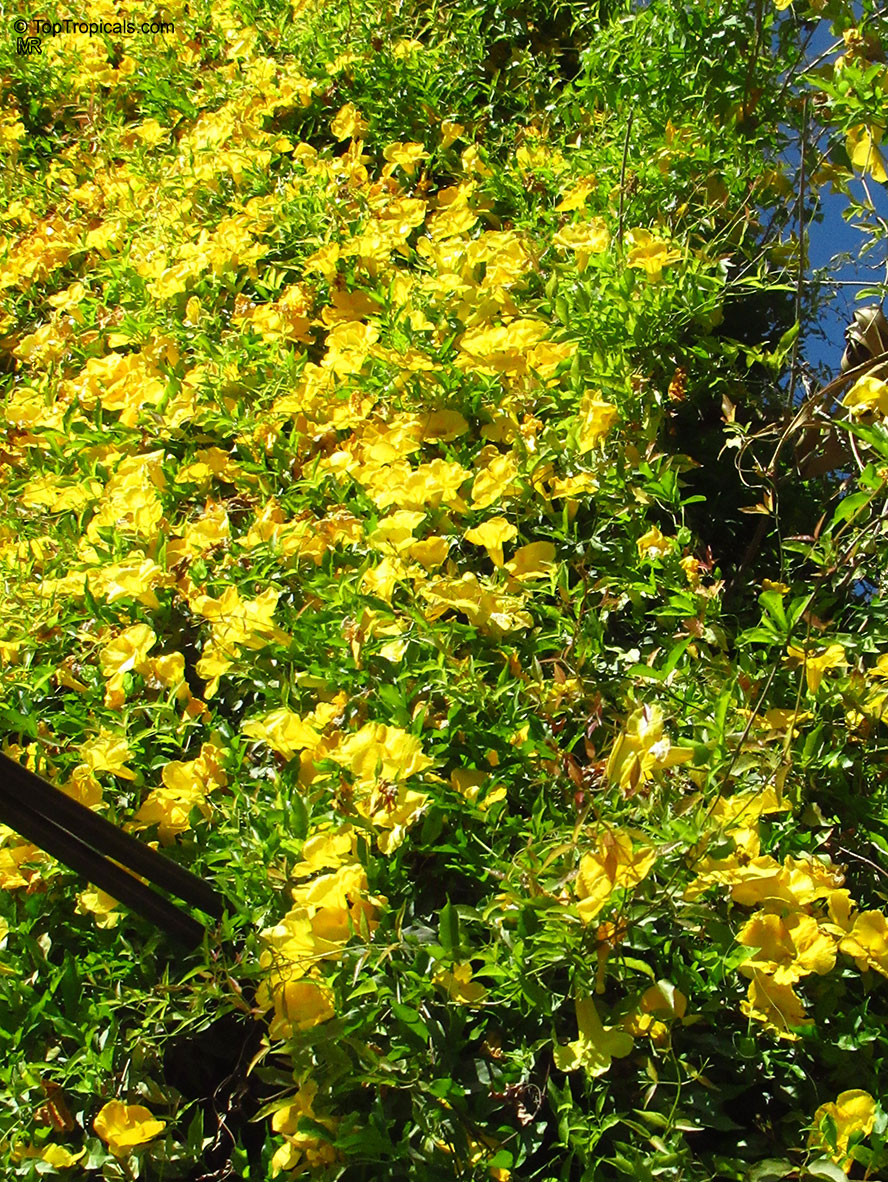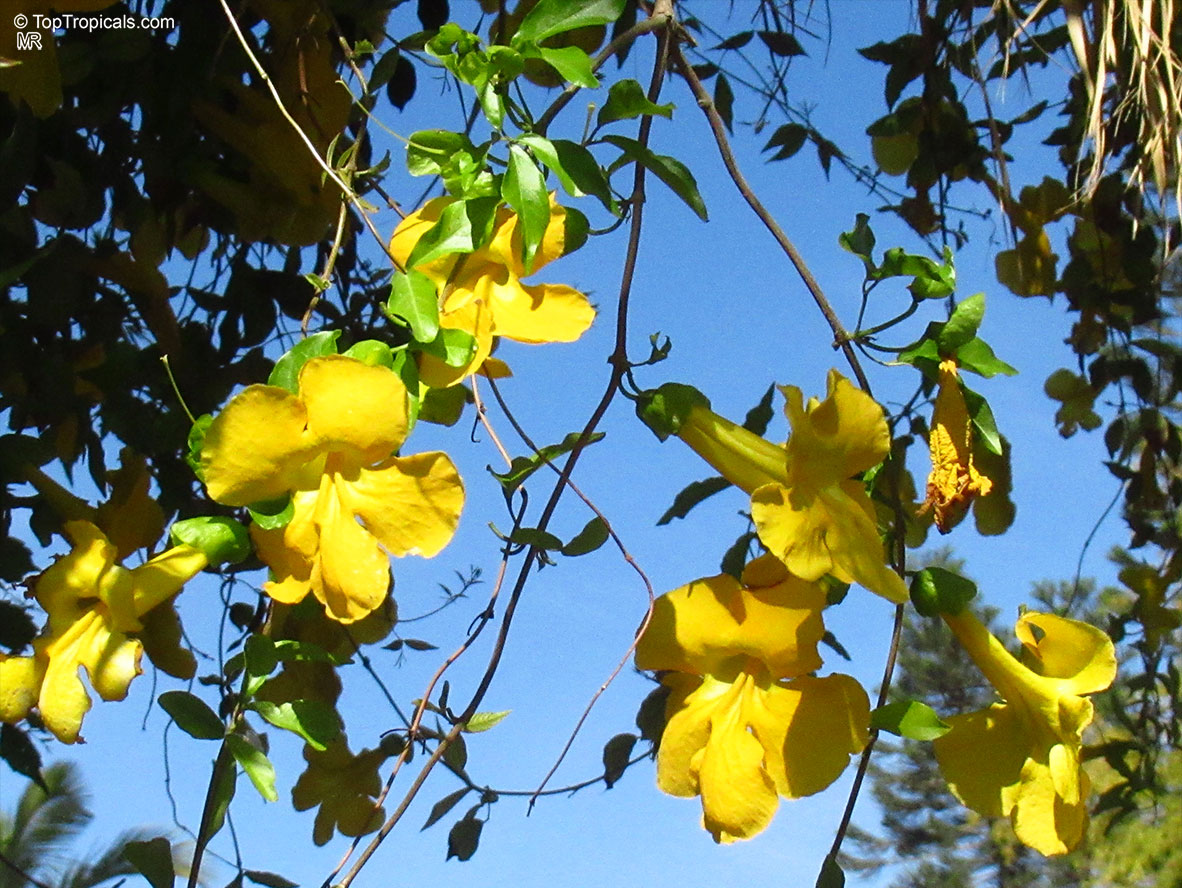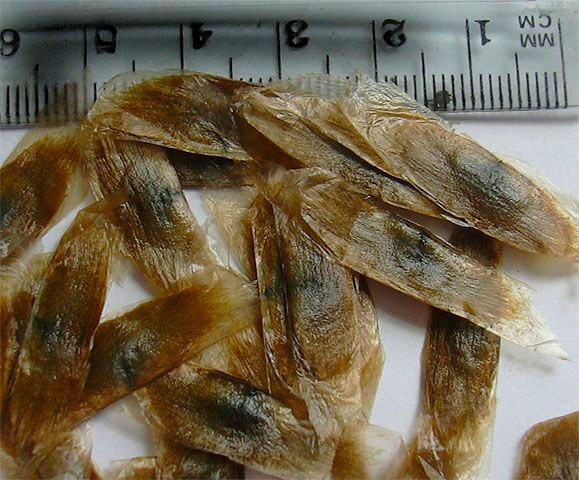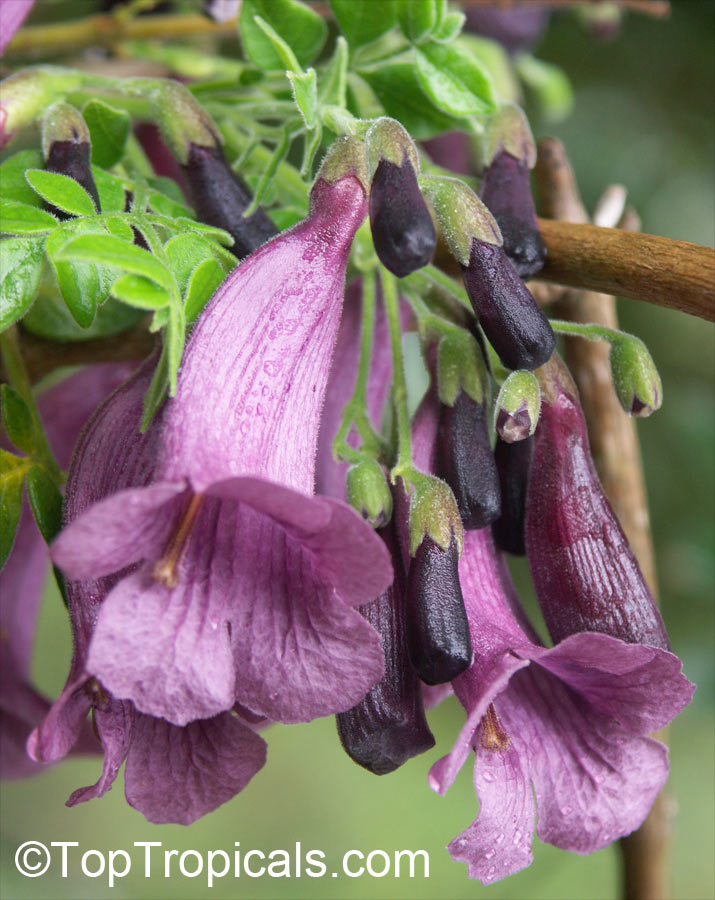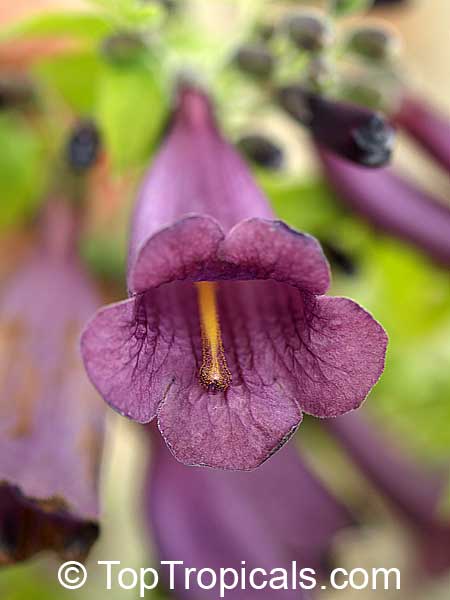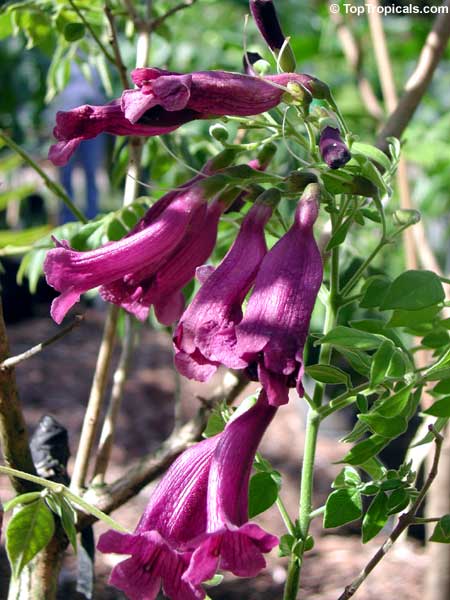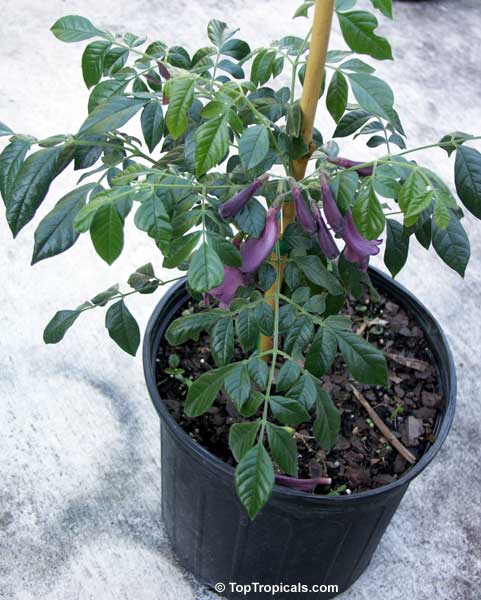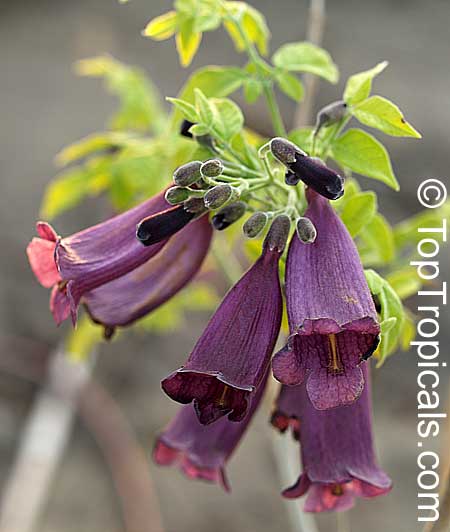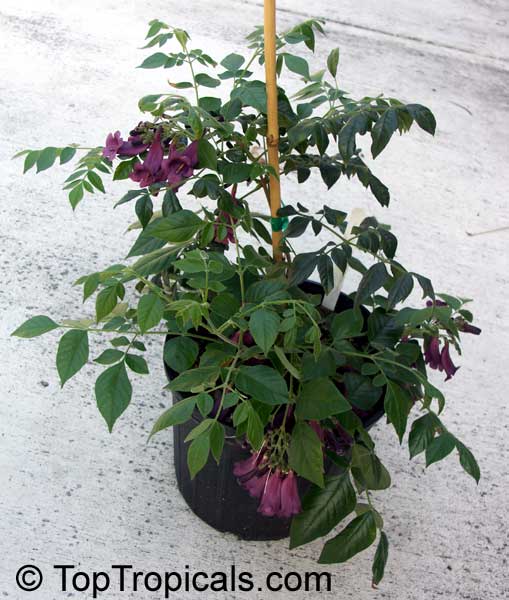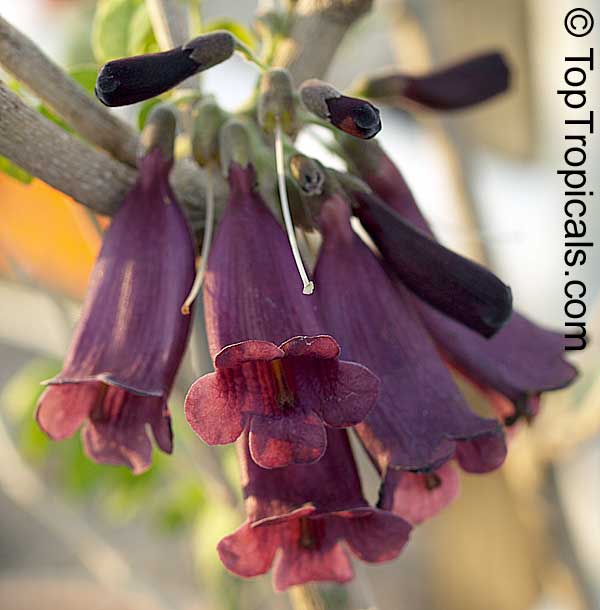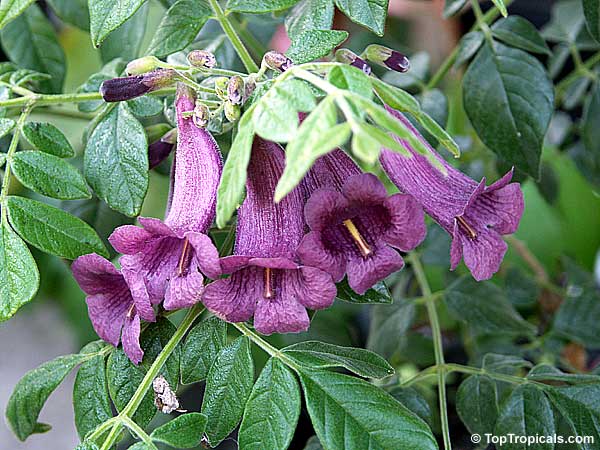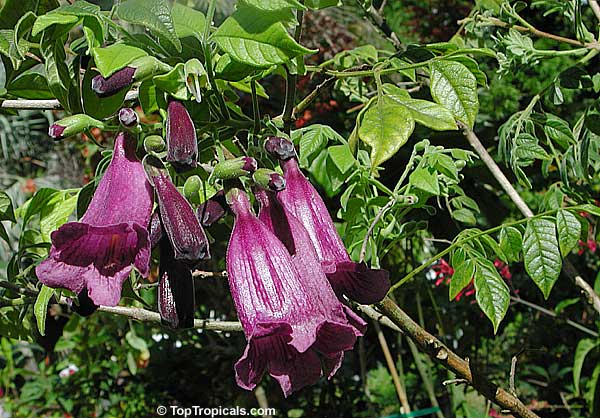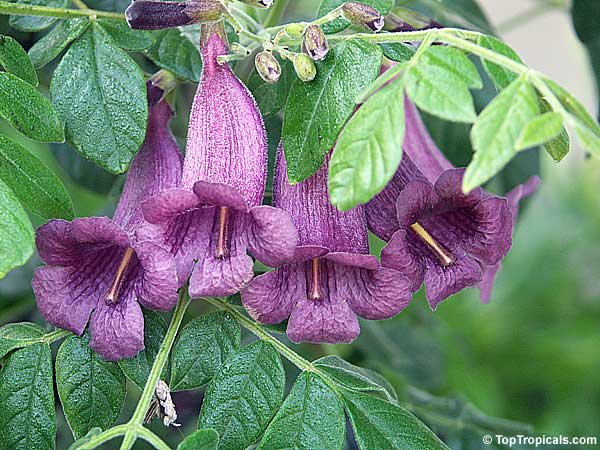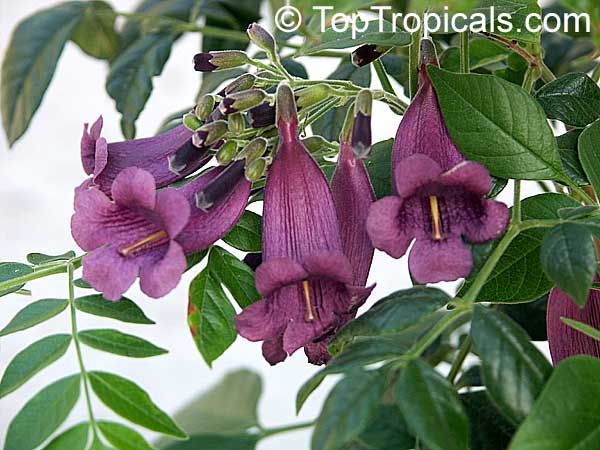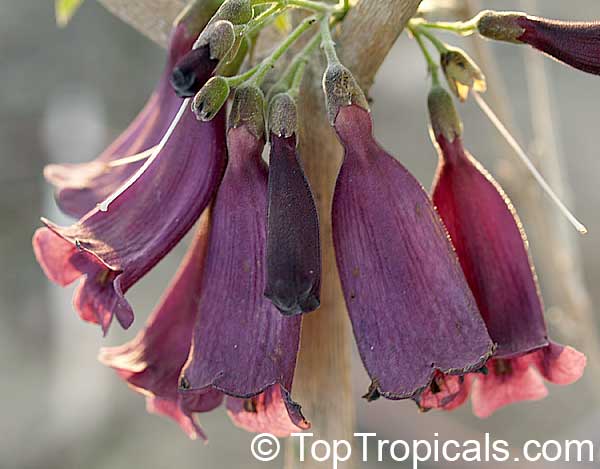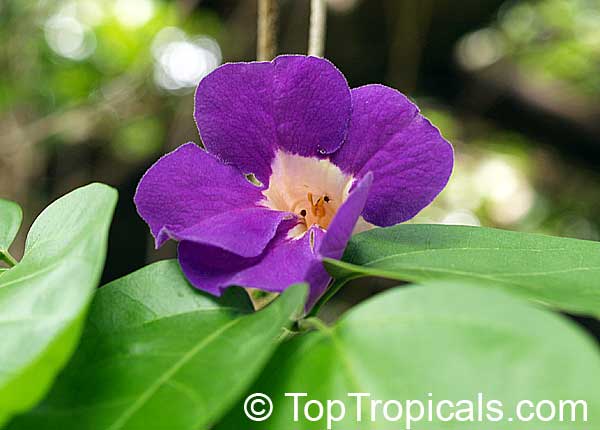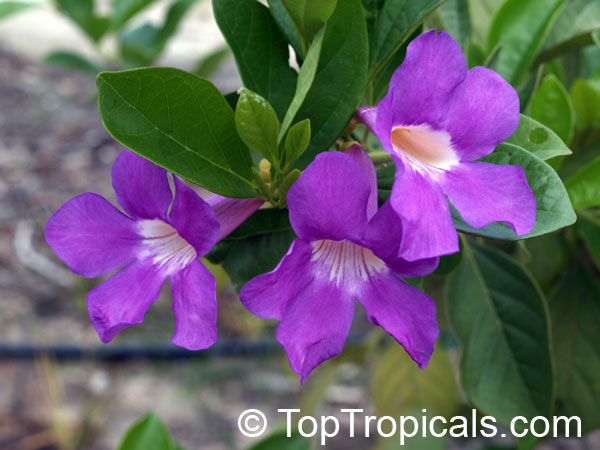Bignonia - Plant Encyclopedia Results
Top Tropicals Plant Encyclopedia
| Number of plants found: 80 | Next | 
|
Go to page: | 1 | 2 | 3 | 4 | 5 | Last |
Botanical names: Adenocalymna comosum, Bignonia comosa
Common name: Yellow Trumpet Vine
Family: Bignoniaceae
Origin: South America





Adenocalymna comosum (Yellow Trumpet Vine) is a creeper native to South America that is renowned for its beautiful yellow and orange flowers. It thrives in full sun or semi-shade and requires regular water to remain healthy. It is suitable for growing in USDA Zones 9-11, making it a great option for gardeners living in mild climates.
Yellow Trumpet Vine is an evergreen vine and needs support to grow on, such as trellis or wire. Its leaves are small, lanceolate and arranged in opposite pairs. It flowers in early spring producing many long tubular yellow or orange flowers, grouped in terminal plume-like inflorescences. The flowers open successively and display a steady flowering state over several weeks.
If you are growing the Yellow Trumpet Vine in a pot, then it is best to use a well-draining soil with a slow-release fertiliser. In cooler climates, it is best to move the pot indoors in winter to provide protection from frost. To encourage healthy growth and flowering, deadhead any faded flowers, and prune the plant if it gets too large or leggy. A yearly prune will also help to keep the plant from becoming unruly.
With its beautiful flowers, Adenocalymna comosum is a great addition to any garden. With its easy-care requirements and ability to thrive in mild climates, the Yellow Trumpet Vine can be a real showstopper in any outdoor space.
Botanical names: Anemopaegma chamberlaynii, Bignonia chamberlaynii
Common name: Yellow Trumpet Vine
Family: Bignoniaceae
Origin: Brazil





Botanical name: Bignonia capreolata
Common name: Crossvine
Family: Bignoniaceae
Origin: North America
Hardiness: 15°F








Fast-growing cross-vine with unique leaves - two leaflets per leaf; the rachis ends with a tendril. The common name comes from the cross shape seen when you make a cross-section of a stem, makes an outstanding screen. Will scramble up a trellis or any other support quickly and easily. It is hardy and relatively pest free. The deep red buds in spring open to reveal a cheery yellow inside. Unscented tubular flowers appear in late April. Prune as desired.
Botanical names: Bignonia magnifica, Saritaea magnifica
Common names: Glowvine, Purple Bignonia, Saritaea
Family: Bignoniaceae
Origin: Colombia







It is an evergreen woody vine native to Colombia that flowers during the summer.
Glowvines reach between 10-15 feet of height and spread at the same rate. They grow best in full sun or semi-shade, provided they have access to regular water in the summer months when the blooming is at its peak. To achieve the most lush flower production, fertilization should take place during the growing season. Plant care will be easier if they are grown in pots during the winter in colder regions.
The flowers of Saritaea magnifica, also known as Glowvine, come in shades of blue, lavender and purple and attract butterflies, bees, and hummingbirds due to the bright colors and sweet nectar. This vine blooms starting in the spring and continues up until the fall creating an array of colors in the garden.
Glowvines are suitable for growing in the USDA Zones 9-11 and can be great for creating a vibrant landscape. While this plant is not frost hardy and can suffer from cold temperatures, if grown in pot, it can likely be brought indoors during the winter months to ensure a longer lifespan.
Botanical names: Campsis grandiflora, Bignonia grandiflora, Campsis chinensis
Common name: Chinese Trumpet Creeper
Family: Bignoniaceae
Origin: China









A rapid-growing vine that provides excellent cover for fences, walls, arbors or large trellises. May also be grown on the ground to cover tree stumps or rock piles.
Needs support; partly twining; few aerial roots.
Hardiness Zone: 7-9
Campsis × tagliabuana 'Madame Galen' is a hybrid between Campsis radicans and Campsis grandiflora.
Botanical names: Clytostoma callistegioides, Bignonia lindleyana
Common names: Violet Trumpet Vine, Lavender Trumpet Vine
Family: Bignoniaceae
Origin: South America










Clytostoma callistegioides (Violet Trumpet Vine) is a perennial vine native to South America. It can easily reach heights of 15-20 feet, making it an excellent choice for covering trellises, walls, or even large fences. Once established, this vine will grow quickly, and soon you will be rewarded with its spectacular display of colorful blossoms. Violet Trumpet Vine requires full sun in order to flower and grow, but it also enjoys a bit of shade, especially during the hottest times of the day. It should be kept moist, and will benefit from regular watering and fertilizing during the growing season.
Violet Trumpet Vine produces stunning pink, white, off-white, blue, and lavender-colored flowers that bloom in the spring. These flowers will remain on the plant for four to six weeks attracting both butterflies and hummingbirds. It can be grown in USDA Zones 9-11. When mature, the Violet Trumpet Vine can tolerate temperatures down to 30°F for a short time, making it a great choice for seaside and salt-tolerant plants.
If you live in a cold region, the best way to keep your Violet Trumpet Vine healthy is to grow it in a pot, as this allows you to move it indoors during colder months. Keep the pot in a sunny location, provide regular water and proper fertilization, and you can enjoy its impressive display for many years to come.
Botanical names: Distictis buccinatoria, Phaedranthus buccinatorious, Bignonia buccinatoria, Amphilophium buccinatorium
Common names: Mexican Blood Flower, Blood Trumpet Vine
Family: Bignoniaceae
Origin: Mexico







This tropical evergreen vine bears clusters of funnel-shaped red-to-purple flowers with yellow bases amidst shiny, evergreen leaves.
Related species: Bignonia campsis.
Botanical names: Dolichandra unguis-cati, Macfadyena unguis-cati, Doxantha unguis-cati, Bignonia tweediana
Common name: Cat's Claw
Family: Bignoniaceae
Origin: Central America
Hardiness: 10°F







Dolichandra unguis-cati (Cat's Claw), a tropical vine native to Central America, is a showstopper in outdoor gardens. Reaching up to 25 feet tall, this fast-growing evergreen is ideal for use as a climber on large trellises, or to trail gracefully over arbors or other structures. It is wonderfully fragrant, with small yellow and orange flowers emerging in the spring.
Cat's Claw likes full sun to partial shade and does well in most soil types. It's drought tolerant and doesn't require a lot of water, but does best with occasional watering in the summertime. In the colder regions, planting it in a pot and bringing it inside during the winter months is the best way to ensure it survives.
When grown outdoors, Cat's Claw is a USDA hardiness zone 9-11. When planted in a pot, it should not be placed in direct sun, and can be kept in full sun through the late fall. It prefers well-draining soil and should be watered regularly. It can go without water for a few days, but for best results, keep it damp, but avoid overwatering.
Propagation is easy and can be done through seeds, stem cuttings, and offsets. But be aware that handling Cat's Claw can cause skin irritation or an allergic reaction in some people, so be sure to wear gloves when planting or pruning it.
With its fast growing speed, fragrant flowers, and easy care, Cat's Claw is a popular plant for any outdoor space. The showy foliage grows quickly and provides a beautiful backdrop in the garden. Plus, it can add a tropical feel to even the coldest regions. With the right conditions, it can be a stunning addition to any garden.
Botanical names: Jacaranda jasminoides, Jacaranda curialis, Bignonia curialis
Common name: Dwarf Maroon Jacaranda
Family: Bignoniaceae
Origin: Brazil







Maroon Jacaranda is a captivating dwarf tree or large shrub renowned for its rich maroon-purple trumpet-shaped flowers. Native to Brazil, this ornamental plan is cherished for its compact size and vibrant blooms. Deciduous or evergreen shrub or small tree, 10-15 feet tall. This dwarf jacaranda blooms when still small, in 1-3 gal pot. Good choice for small gardens or patio, can be grown as a house plant near a bright window or in a greenhouse. Young trees are frost sensitive (to 25F) and need protection on the coldest nights. Adult trees are resistant to 20F.
Jacaranda jasminoides Maroon is a charming, compact tree that brings a touch of drama to small gardens and patios. It usually grows between 10 and 25 feet tall, with a bushy habit that makes it perfect for tight spaces or even containers. What really steals the show are its deep maroon to dark purple trumpet-shaped flowers that bloom in clusters from late spring through summer. In warm climates, it may surprise you with blooms at other times too! The fine, fern-like leaves add a delicate, lacy texture to the overall look.
This jacaranda loves full sun but will tolerate a bit of shade, and it is happiest in fertile, well-drained soil. Water it regularly when it is young or during dry spells, but once established, it is fairly easygoing. It s best suited for USDA zones 9 to 11, and while mature plants can handle brief cold snaps down to 20F, younger ones appreciate a little extra protection when the temps dip.
Whether in the ground or in a pot, the Maroon Jacaranda is a low-maintenance beauty. A little pruning here and there keeps it tidy, and its elegant blooms make it a standout wherever it s planted. In warm places it may keep its foliage year-round, giving you a long-lasting touch of tropical color. A great pick for anyone who wants big color in a small footprint!
This jacaranda loves full sun but will tolerate a bit of shade, and it's happiest in fertile, well-drained soil. Water it regularly when it's young or during dry spells, but once established, it's fairly easygoing. It is best suited for USDA zones 9 to 11, and while mature plants can handle brief cold snaps down to 20F, younger ones appreciate a little extra protection when the temps dip.
Whether in the ground or in a pot, the Maroon Jacaranda is a low-maintenance beauty. A little pruning here and there keeps it tidy, and its elegant blooms make it a standout wherever it is planted. In warm places it may keep its foliage year-round, giving you a long-lasting touch of tropical color. A great pick for anyone who wants big color in a small footprint!
Botanical names: Mansoa verrucifera, Bignonia verrucifera, Onohualcoa verrucifera
Common name: Mansoa
Family: Bignoniaceae
Origin: Mexico to Guyana and Brazil







Mansoa verrucifera, more commonly known as Mansoa, is a woody vine or creeper native to Mexico to Guyana and Brazil. Its leaves are opposite and trifoliate, with an elongate and more or less round fruit in cross-section with bumpy surfaces. It has bright and beautiful flowers, which can be found in a variety of colors, including pink, blue, lavender, and purple.
Mansoa is an ideal choice for growing outdoors in USDA Zones 9-11. It prefers full sun or partial shade and requires regular water. If grown in colder regions, it is best to keep it in a pot. While it prefers regular watering, it can tolerate low water if necessary.
Mansoa is an attractive and vibrant plant, with its bright and colorful flowers. With the right care, Mansoa can add beauty and vibrancy to any garden.
| Next |  |
Use link to repeat this search:
https://toptropicals.com/cgi-bin/garden_catalog/cat.cgi?find=Bignonia&search_op=and&keyword_op=and&language=e&number=10
&no_change_lang=1&user=tt&sale=1&first=0

